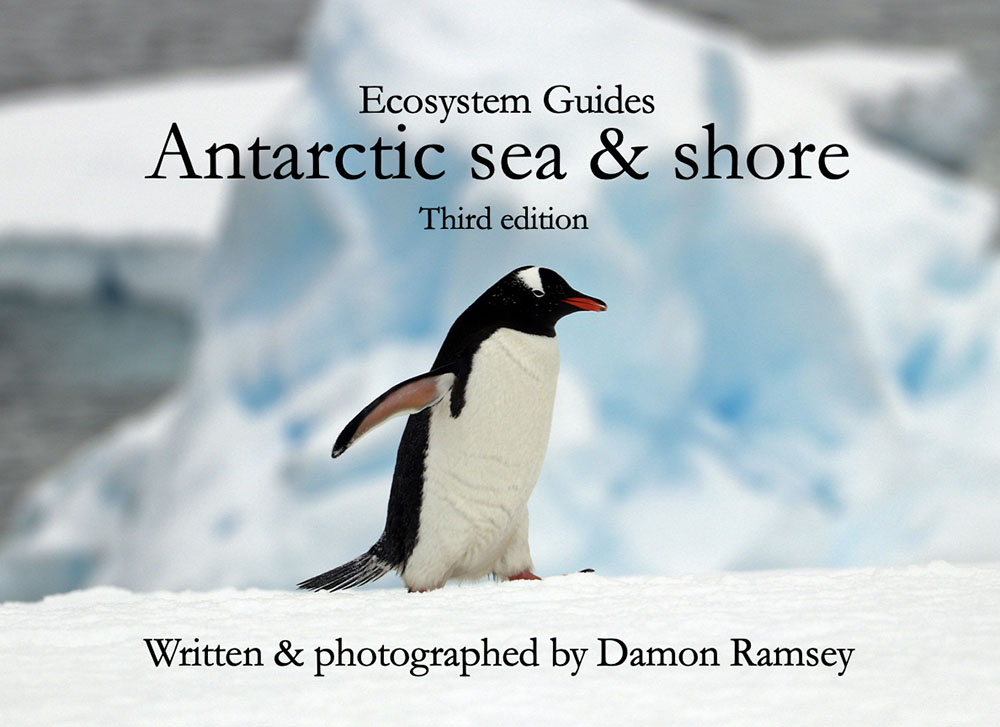ecosystem-guides.com
....exploring the planet's ecosystems
INDO-PACIFIC
Tropical Seashore
Like any ecosystem, the tropical seashores include a distinct range of specific plants and animals. However, because of the wide distribution ability of marine, intertidal and island organisms, many of these same seashore flora and fauna species are found around a huge part of the planet.
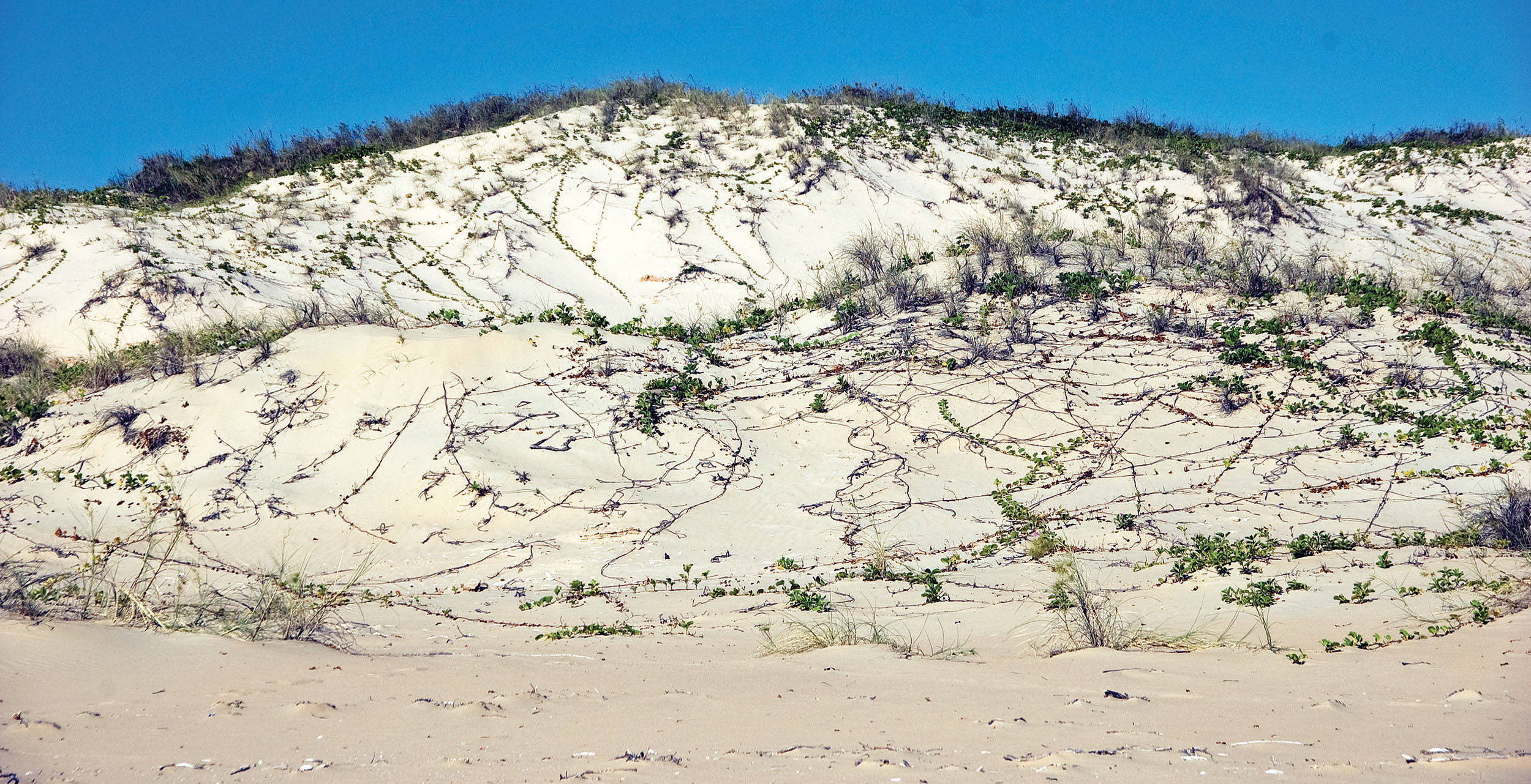
Ecosystems are often hard to define, and they depend on the scale of the observer. Tropical seashores are here considered an ecosystem defined by their tropical geography, intertidal location and characteristic seashore vegetation.
One of the best ways to define an ecosystem is simply by describing them. This tropical seashore itself can then easily be divided into different recognizable zones. These are examined and described below. These zones occur in either of the two overlapping worlds that make up the tropical seashore: the marine intertidal and the terrestrial vegetation communities.
The marine intertidal zone is that region which is covered by water at some time during the regular tidal cycle. The dividing up of this intertidal area into various zones can be based on different factors such as the substrate (sand, mud, rock, etc) or their proximity to the ocean (submerged, intertidal, splash zone, etc).
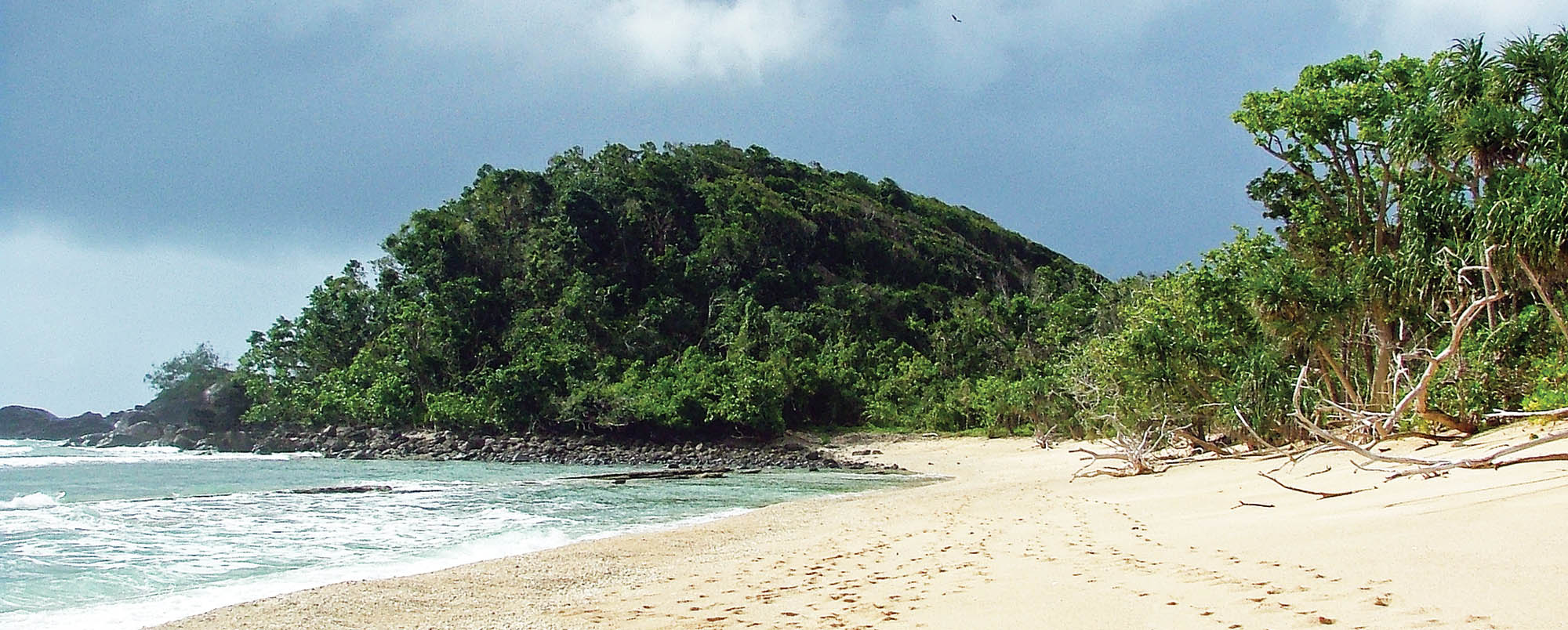 the tropical seashore includes many habitats (Frankland Islands, Queensland)
the tropical seashore includes many habitats (Frankland Islands, Queensland)Just above the intertidal area, there is a similar zonation, but this based on vegetation type, and divided into ‘vegetation communities’. There are various plants that have adapted to the life on the tropical seashore. These plants are characteristic of the shore, and most species do not grow too far into the forest or woodlands behind it (although there are often closely related species). They are usually technically referred to as littoral plants. But they are often commonly called ‘beach’ or ‘island’ plants. These plants are widespread throughout the tropical oceans, and include species such as Beach Callophyllum, Pandanus, and today, Coconut. (Some of these species found here overlap with the Australasian Mangroves and Asian Mangroves). Each species’ different requirements and adaptations to certain environmental conditions determines where they grow on the seashore, and there tends to be clumps of certain species that grow together in particular zones. Like the intertidal zone, these conditions are usually set by factors such as substrate and the proximity of the ocean. This often results in zones that develop roughly parallel to the ocean. There are various examples of different authors and their classification of zones based on seashore vegetation in the Tropical Pacific (eg: Whistler 1992).
Rocky shores are a much loved and explored part of temperate coasts around the world. However, they are not as obviously common along the tropical coast. For here, the more abundant shallow continental shelves or fringing reefs reduce the wave action, and this tends to instead promote the development of deposition landforms, such as sandy beaches and muddy bays. However, within the limited rocky shore habitat, there is a huge range of different types along the tropic coasts of the world. For example, between the coral offshore and the sand of the beach, there often lies a transitional rubble zone of what appears to be dead material, made up of broken coal, interspersed with sandy areas. And just under the tide and up onto the beach there is also often a zone of ‘beach rock’, a cemented mix of coral, shells and sand, that usually form platforms. And on continental shelf islands and along certain coasts, rocky habitats range from resistant granite boulders to cliffs and caves of sedimentary sandstone.
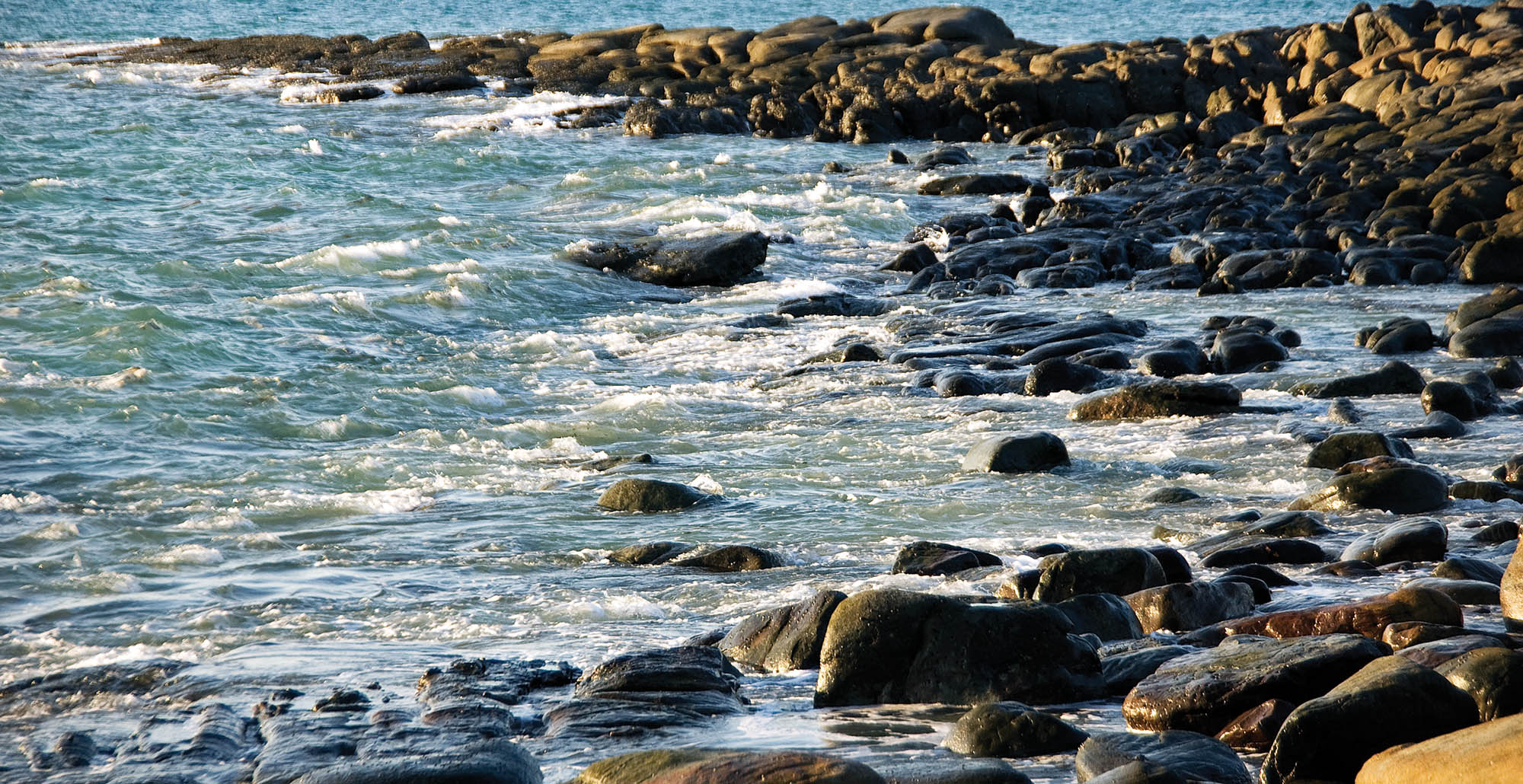
Life on tropical seashores is not always as obvious as it is along temperate shores. First time or casual visitors to tropical rocky shores who have grown up along cooler coasts are often disappointed at the apparent scarcity of life here. This is largely due to the harsher conditions. Warmer waters hold less oxygen than cooler waters, so there is generally less life in the tropical seas off the coast. Less oxygen means less nutrients in the water, and therefore there is an obvious lack of the filter-feeding animals such as barnacles, oysters and mussels. And in the exposed areas and rock pools, the heat of the tropical sun results in higher temperatures, which leads to higher rates of evaporation, and thus higher salinity levels.
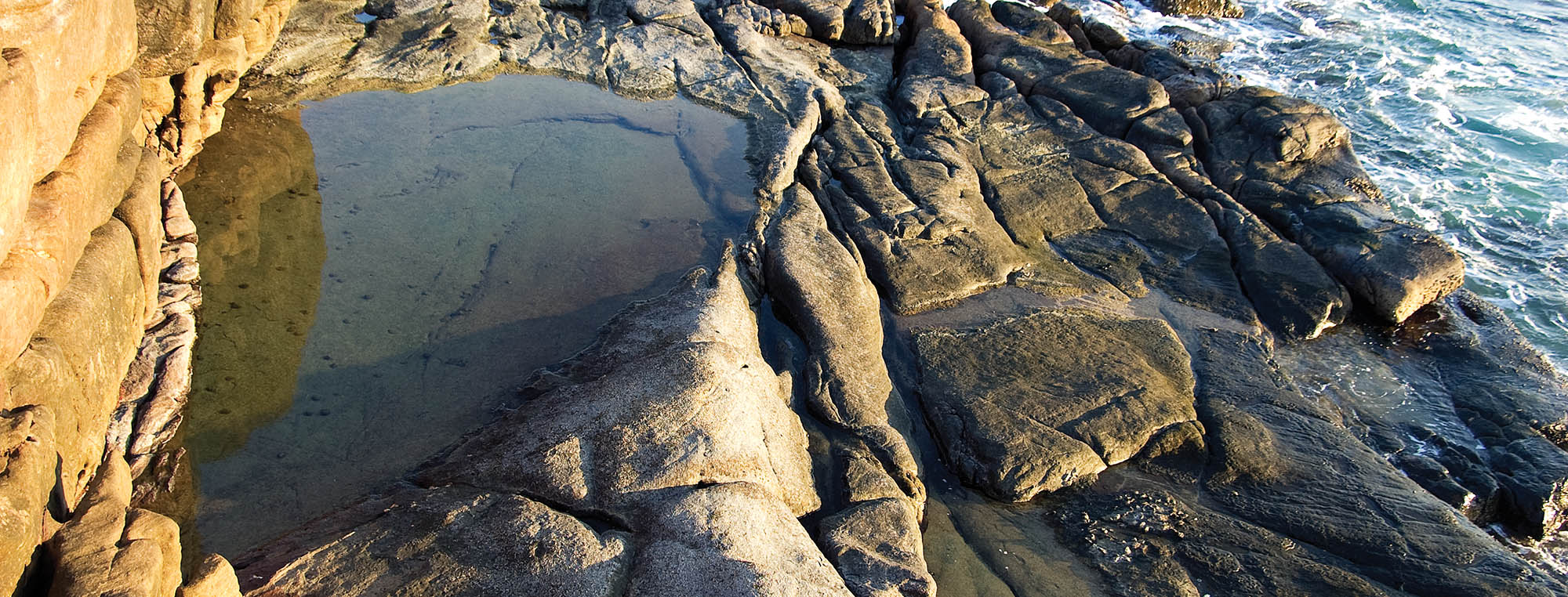 rock pool on tropical seashore
rock pool on tropical seashoreHowever, many of the ecological principals of tropical rocky habitats are similar to their temperate counterparts. There are distinct zones, distinguished by colour and shape of the rocks, and the species living there. Above the intertidal zones is the normal bedrock. Below that is a salt-whitened ‘splash zone’, a severe place where few intertidal animals live, but lizards may scurry. Below this is the intertidal area. This is frequently blackened by cyanobacteria and has a variety of different animals grouped at different levels. There is sometimes an eroded shelf or even platform at this intertidal level and, as in temperate shorelines, there are invariably rock pools in these flatter areas.
Within the intertidal area, different animals tend to live at slightly different heights. Small shells called winkles graze the upper intertidal areas. Within the upper middle areas, barnacles feed when covered by water at high tide, but can survive exposure by closing up at lower tides. In the middle areas there are several animals that roam around. Some are extremely slow, such as the grazing limpets and chitons. Much faster are the cockroach-like marine slaters. In the lower middle zones are more sedentary animals, such as the sharp-shelled tropical oysters, and in the lower tidal areas are the mussels.
 zonation on rock wall along tropical seashore
zonation on rock wall along tropical seashoreThe long white sandy beach is the image many visitors often have of the tropical seashore. The reality is somewhat different. There are many different types of sands and beaches. On the more typical large grained beaches of the tropics, the soft sand is often interspersed with sharp coral. On some beaches it may in fact be made up entirely of coral.
Tropical beaches are not all that conducive for obvious life. They are exposed and therefore hot. Their shifting substrate of sand in the intertidal area means they are bare of large plants (if plants do colonize the beach, it may develop into a mangrove). Many of the larger animals that are seen here are just occasional visitors, such as some shore birds or breeding sea- birds. The obvious resident animals are often scavengers that wait for debris to wash up from the adjacent ocean, such as ghost crabs. But there is also a range of smaller animals at the surface of the sand, and an even larger range of tiny microscopic animals just underneath.
 (sandy intertidal area along Cable Beach, West Australia)
(sandy intertidal area along Cable Beach, West Australia)In areas of higher tide or in protected bays, finer sand and mud will accumulate. These seashores are much richer in life within their fine-grained substrate. They subsequently attract many more of the feeding shore birds. These softer seashores in more protected estuaries commonly end up with mangrove forests growing on their edge.
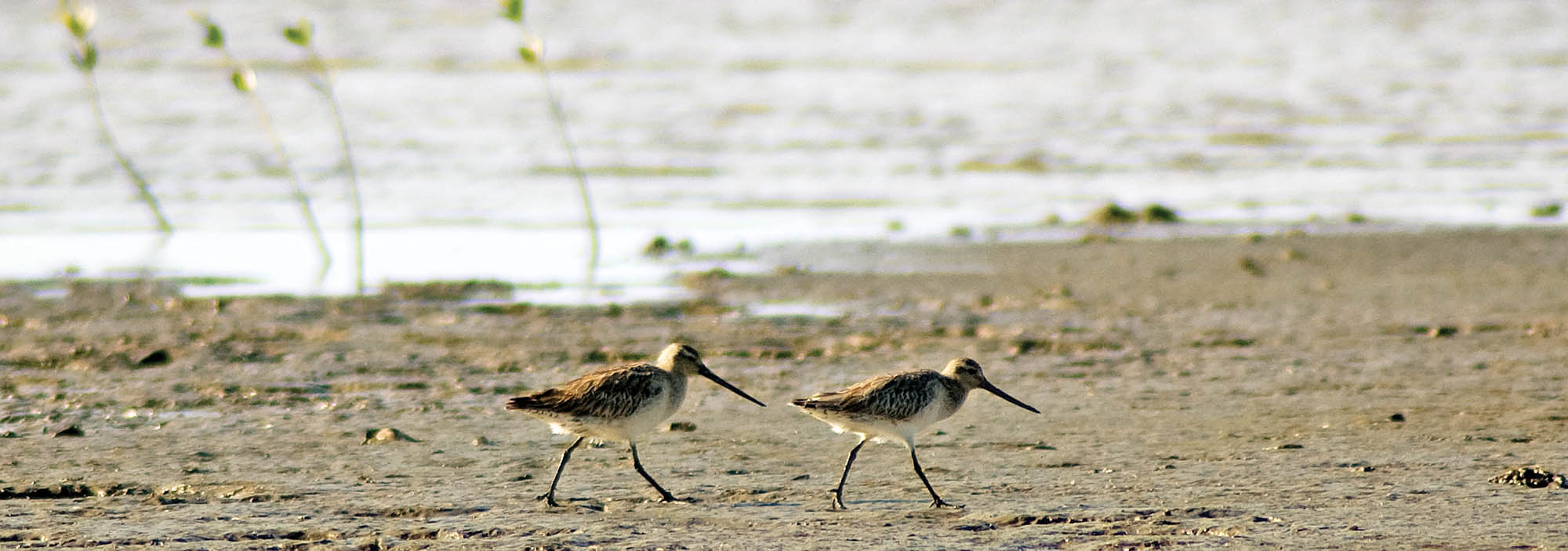 (feeding waders on the famous Cairns mudflats, along the esplanade, Queensland)
(feeding waders on the famous Cairns mudflats, along the esplanade, Queensland)In an ecological sense, there are two main groups of plants that live along the seashore, which correlate with the two very different sides of the habitat. There are the plants that live in the ocean itself, or at least regularly “get their feet wet”. This includes the true marine groups, such as many seaweeds, as well as the sea grasses (to be covered in the section on Coral Reefs), and the intertidal plants, such as the mangroves (covered in various sections such as Australasian Mangroves and Indo-Malayan Mangroves). Then there are the land based plants that are covered here, many of which have adapted to live right on the seashore sand or rock, where they are exposed to sun, wind, and salt. These are some of the most widespread species on the planet Earth. You will often see the same species over and over again from the east coast of Africa, across tropical Asia, and all the way to the most remote islands of eastern Polynesia. Learn and identify these species, and you can be clever all over the world!
Among the more dramatic and interesting features along exposed coastlines are sea caves.
These are caused by the constant pounding of the ocean against the land. The hitting of constant waves all day and every single day has a huge cumulative effect. When the water hits the land it not only takes material off (the weathering), it also takes it away (the erosion). It is the particles that are carried in the water, (more so than the water itself) that acts as an abrasive and grinds away the material.
Weathering by water is not just due to simple physical battering. There is also weakening of the rock due to relatively fast and extreme changes in water and temperature where the sea water hits the land. When there is a rapid change in the volume of water seeping into the rock, and the water expands and contracts with re-hydration and dehydration, this hydration pressure weakens the rock. While the land above is consistently exposed to air and the land below constantly covered, the intertidal area is changing in temperature; it is exposed, then covered by cool water, then exposed and dried again in the tropical heat. Along the tropical coast there is also the addition of rain seeping into the rock through the heavy wet season rains, and then drying out again in the high heat of the summer sun. When temperatures change, they expand and contract the rock, and weaken in the process of thermal expansion.
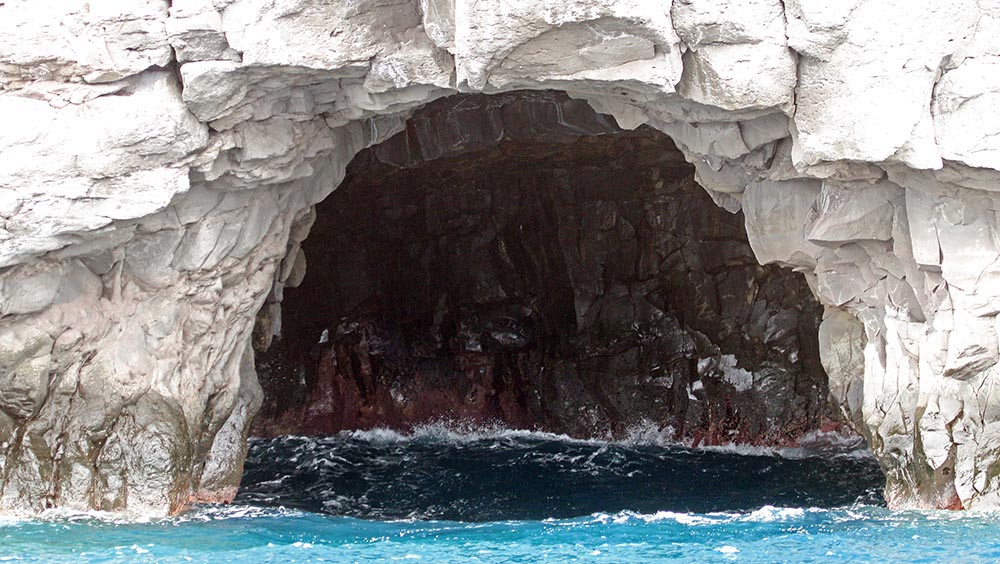 coastal cave (Tonga)
coastal cave (Tonga)Blowholes occur where holes have been weathered down into caves underneath a rocky coast. When waves hit the shore, the water in the underwater cave is forced into the small eroded gap and squeezed out and high into the air. One of the best places to see blowholes in the tropical Indo-Pacific is along the coast of Tonga at Mapu a Vaea.
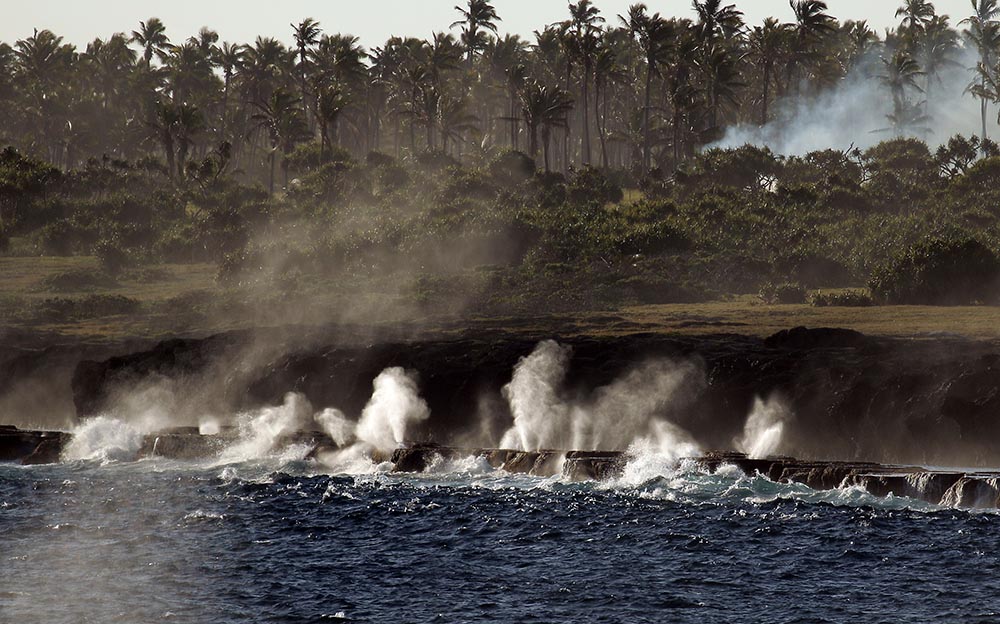 blowholes (Mapu a Vaea, Tonga).
blowholes (Mapu a Vaea, Tonga).There are over 1500 species of ‘brown seaweed’ in the Class Phaeophyceae. As suggested by the common name they are frequently coloured browns and yellows. They have pigments that can photosynthesize in much lower light, and tend to live in deeper waters. Many types of brown seaweed have air-filled, grape-like floats which enable the plant to stay at the surface with the moving tide. They sometimes break free and get washed up on seashores. Sargassum, which includes some of the few free-floating seaweeds. They have many leaf-like stipes with toothed edges, arranged along a ‘stem’, and so they resemble the branches of a tree. They have many brown, grape- like floats. They are very common in the warmer waters around the world, and are probably the most commonly seen group of seaweeds in tropical water. Because many species are not attached, they commonly wash up on tropical shores.
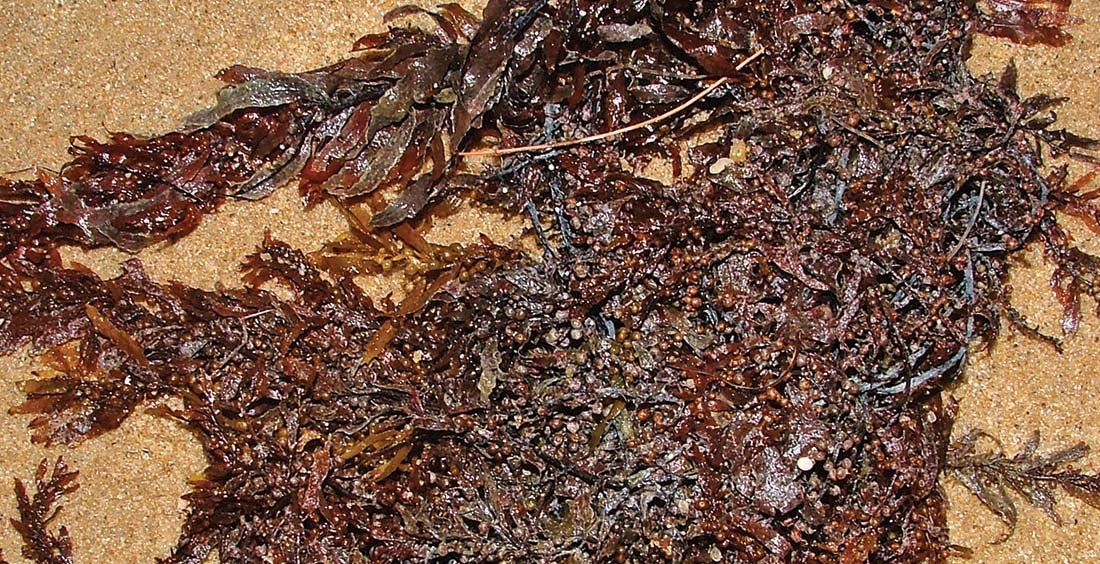 (Cairns, Australia)
(Cairns, Australia)Turbinaria ‘Spiny Tops’ are a very distinctive seaweeds look like spiky, underwater Banksia flowers. They float upright from an attached central stalk, sometimes up to a foot in height, and may even break the surface of the water at lower tides. Along the top half of the stalk many smaller branches grow off to form a dome shape, and each has flat, star-shaped spikes at the end. They can be common in the murkier sandy shallows, and sometimes wash up on tropical beaches.

The 4000 or so different species in this newly erected group within the plant kingdom the division Rhodophyta, the ‘Red Algae’, are commonly known as the ‘red seaweeds’. They by far outnumber the ‘brown algae’ and green seaweeds. Although there are some freshwater species, most Red Algae are marine, and they are especially common in tropical and warm waters. This alga can appear in many different colours such as black, brown and (as suggested by the common name) red. This is due to a red accessory pigment blocking out the colour of the regular photosynthetic green chlorophyll. Because there are many species of red algae living in warmer seas, they commonly wash ashore on the tropical seashore. Many species, particularly those in the family Galaxauraceae, have dichotomous branching, looking like many little stems on a shrub. When washed ashore, red algae often retain attractive red or pink colours. But many will have white; this is from calcification. Because of this, many species may remain stiff and solid after being washed up. But they tend to go brittle, and if the joints are not calcified, the plant may fall into a tangled mess
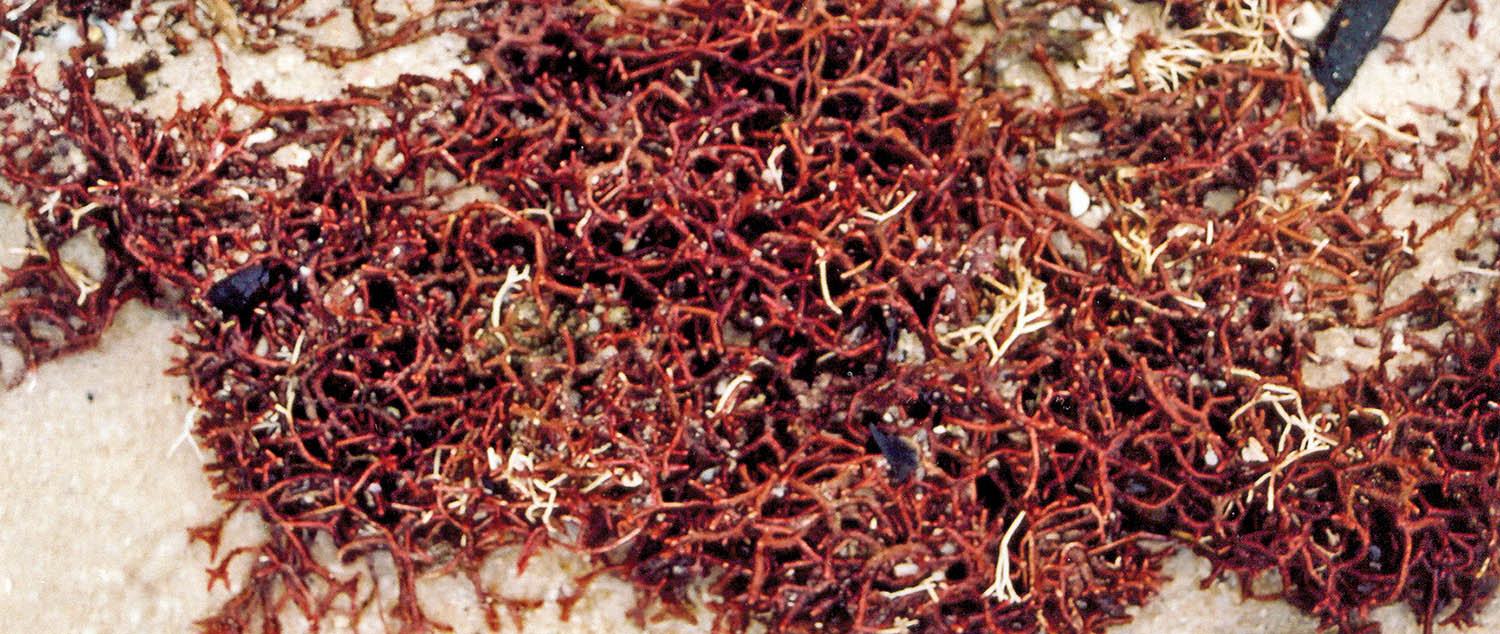
The Green Algae are the most familiar of all seaweeds, and commonly found on seashores around the world. As the name suggests, they tend to be green, but this doesn’t do their range justice, for they occur from deep dark green to bright light green. This green colour is caused by chlorophyll, the same pigment that land plants have. Of all the ‘seaweeds’, these are the closest relatives to the green land plants.
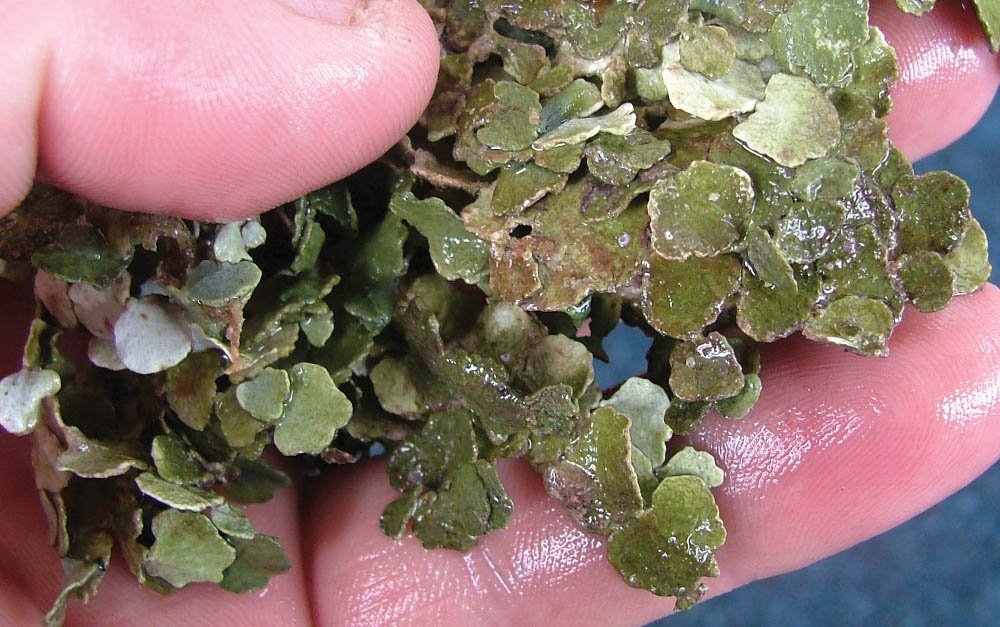 (Great Barrier Reef, Australia)
(Great Barrier Reef, Australia)The species in the group Halimeda are one of the more common seaweeds on coral reefs, and therefore are regularly washed up on adjacent tropical seashores. They are distinct, being made up of many flattened round or square shapes joined together in chains or fanned clumps. Their most important feature is the calcified stiffness of these tiny ‘leaves’. When they wash up, they will bleach to white, but often stay linked together. When they break down they contribute greatly to the sands of beaches, especially coral cays. The genus is named after Halimeda, one of the daughters of Halimedon, Greek King of the Sea.
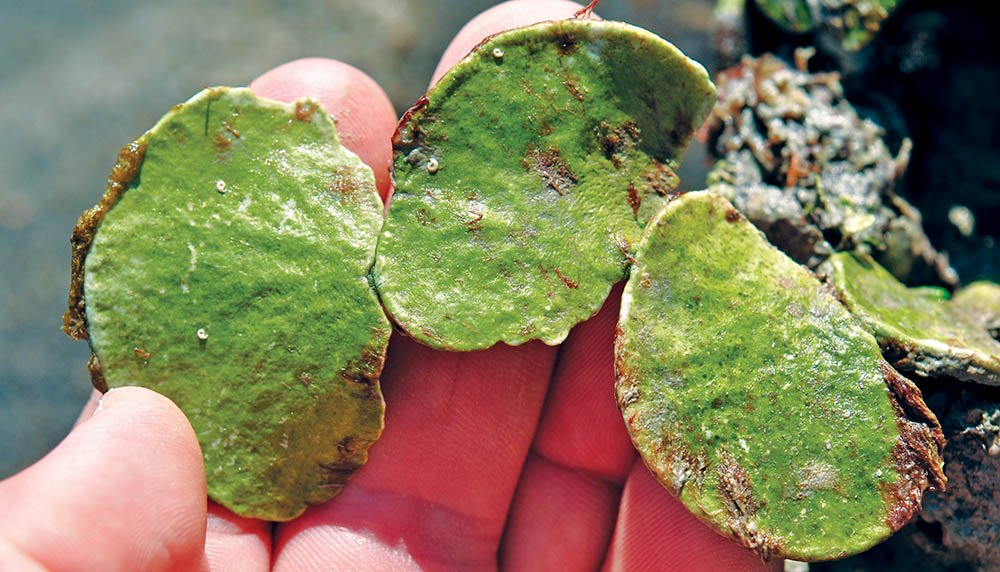
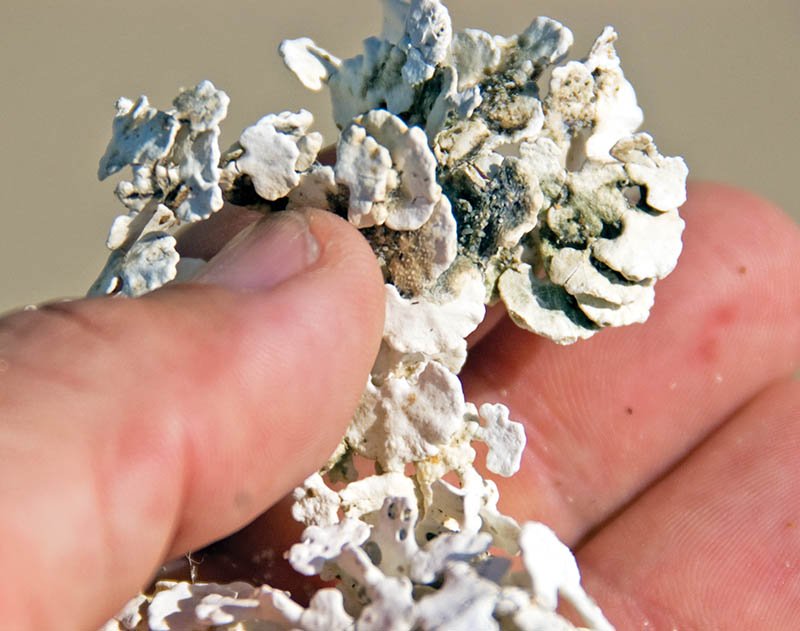
This distinctive family Pandanaceae has 3 genera with 800-900 species, found in tropical Africa, Asia, Australasia and the Pacific. Members of the family include either trees or shrubs of the genus Pandanus, or climbers of the genus Freycinentia. They all have long, strap like leaves, usually with toothed edges. Many species grow unusual roots, such as stilts or ‘brace roots’ off the trunk or limbs. They grow mainly in forests and along coasts in the Old World tropics.
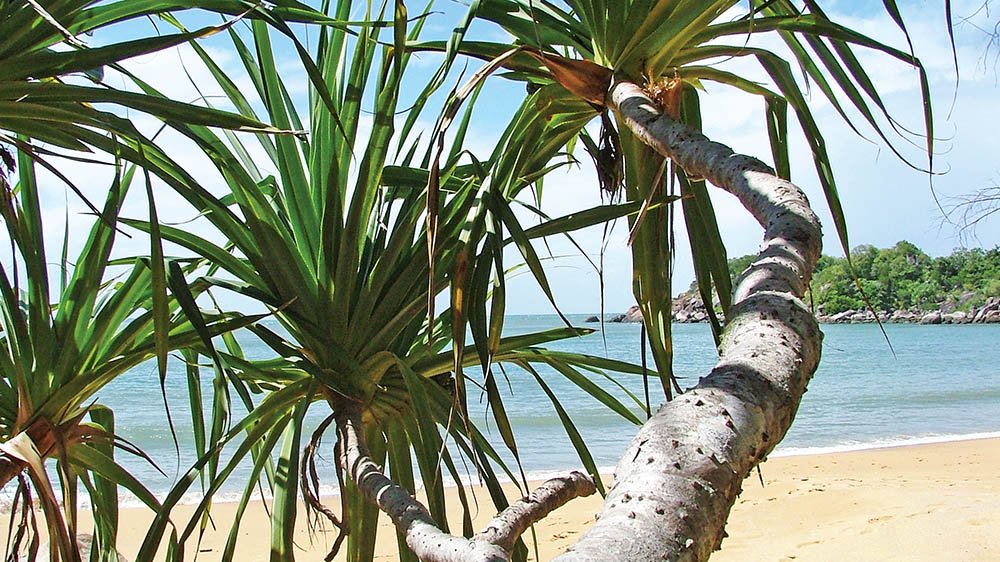 (Hinchinbrook Island, Australia)
(Hinchinbrook Island, Australia)This is the main genus in the family with about 500-600 species, found mainly in the old world tropics. Pandanus are one of the most distinctive and common plants along tropical coasts. They grow slim, almost spindly trunks, superficially rather like a palm, to which they are not closely related. Many species develop stiff prop roots which grow out from the base like tripod legs. Taller, older trees may end up with many roots to a metre or two in height. The long strap-like leaves have spines along the edge, and when they fall they persist for some time, making them ideal material for thatching. The fruits that develop are large and aggregate, almost pineapple like, made up of segments that drop to the ground when ripe. The species of Pandanus along the Australian tropical coast have woody segments, and these wedge shapes are very common along the tropical beaches of Australia. The fruits are edible in several ways. The juicy fibrous ends can be sucked, although this tends to irritate the throat. Each segment also holds a kernel which can apparently be extracted and tastes ‘deliciously nutty’; but good luck trying to open them up! These kernels provided a fat and energy rich food source for Aboriginal people. If the segments wash up later on shore, they are brown, and the fibrous end looks rather like a shaving brush.
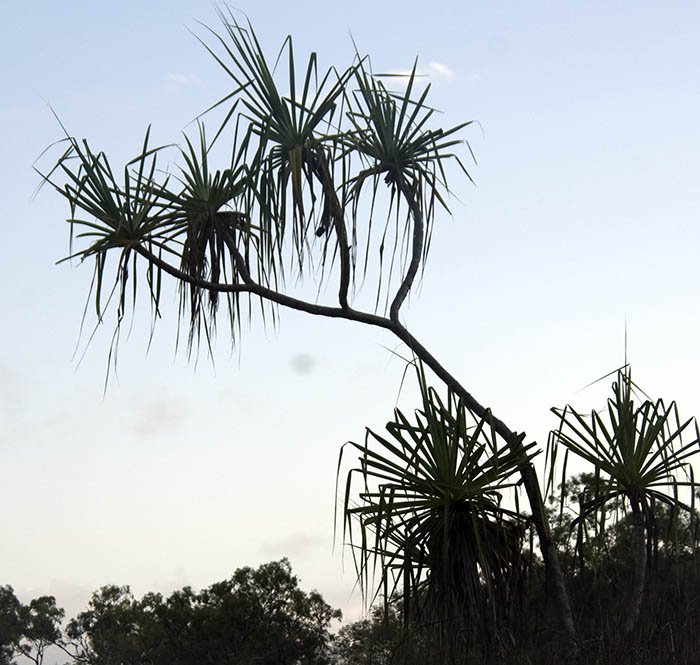
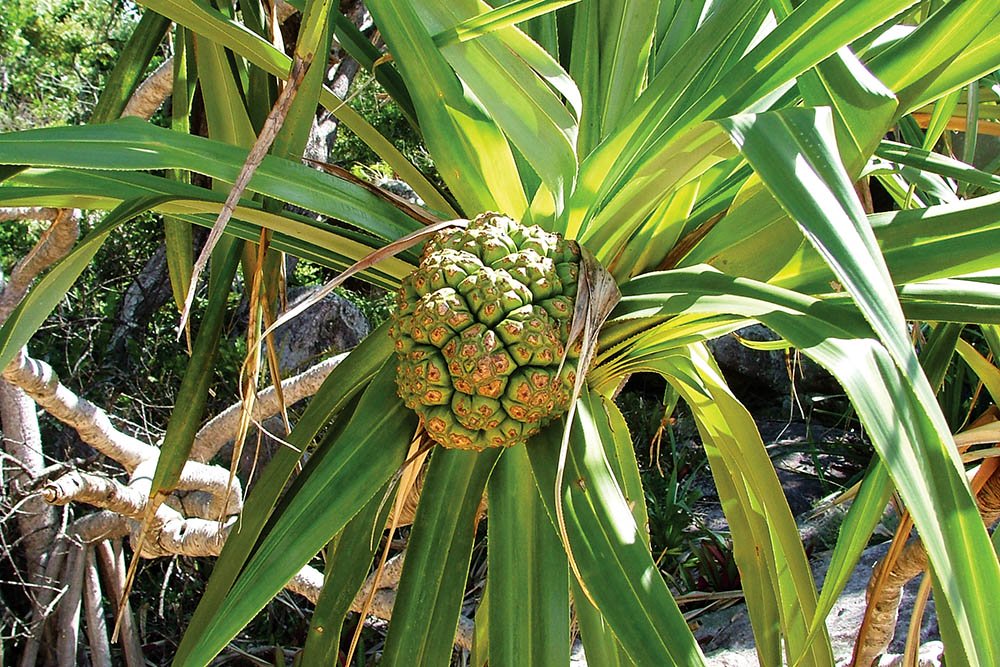
With at least 2,500 species of what we call ‘Palms’, the Arecaceae is one of the biggest and most recognizable of plant families. Only a few species are common on the sandy shores, but among them is the most famous of palms, and indeed the best known and most recognizable of all tropical beach plants, the Coconut. There is only one species in the genus Cocos: the Coconut.
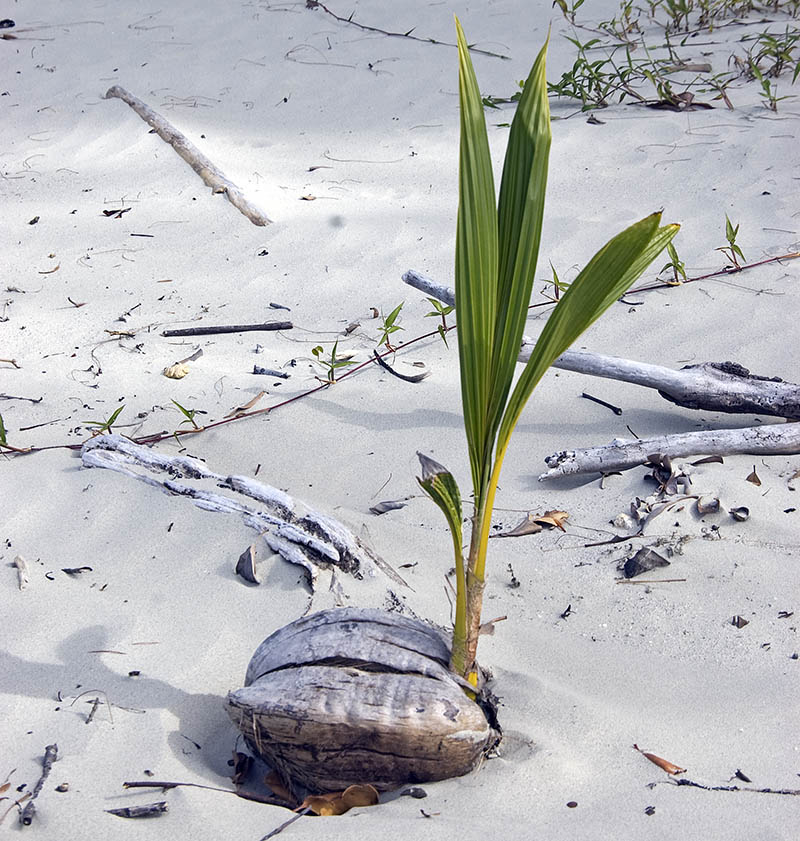
No other plant represents the tropical seashore like the coconut. However, the natural distribution of the coconut palm is an issue of contention, for not only is it a naturally effective disperser, but it has also been spread extensively by humans. It was long noted by European explorers throughout much of the tropical Pacific Ocean, including all the way to the west coast of Coast Rica in Central America; however it is thought to have been introduced into many of these areas. Its original, natural range appears to be centred around the eastern Indian Ocean and south-east Asia. Its distribution along Australia’s coasts is sometimes controversial, with some considering it a ‘weed’. While he observed it in many parts of the tropical Indo-Pacific, explorer Lt. Cook had trouble locating coconuts, (of which he often fed the crew), on his travels along the Australian coastline, and so it has been suggested that Australia was not colonized by coconuts. Today, however, this ‘exotic’ plant is common along the Australian tropical coast, and judging by its effective dispersal techniques and range in the Indo-Pacific, it has probably been there for a long time.
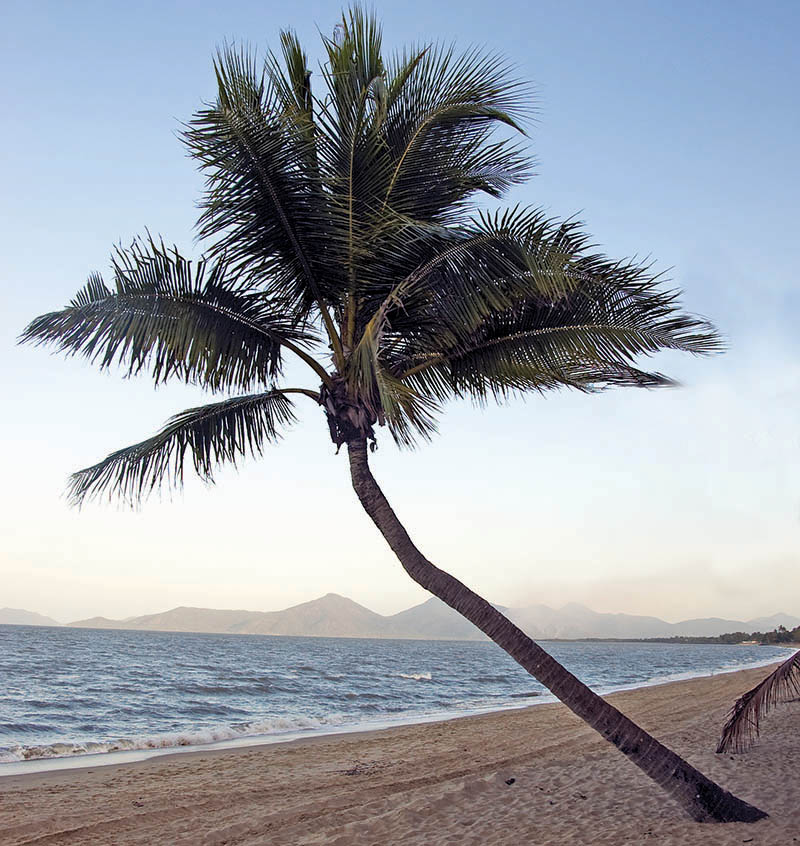 (Holloways Beach, Australia)
(Holloways Beach, Australia)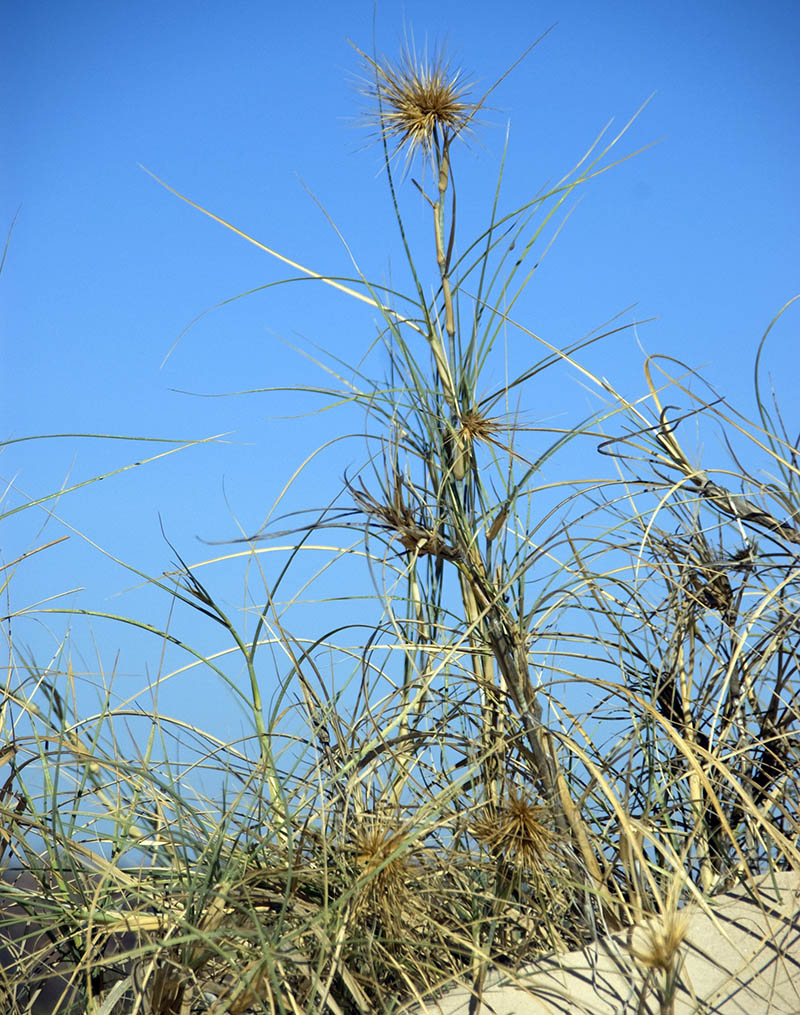
Poaceae is one of the biggest of all plant families, with up to 10,000 species all over the world. Naturally, there are several grasses found in the sand along the tropical seashores.
The 4 species of ‘true spinifex’ found in the Indo-Pacific region are not closely related to the ‘spinifex’ Triodia of arid Australia. They are large grasses, with bunches of leaves growing up from runners through the sand. The many tiny female flowers combine into a large spiky ball. When mature, these come off and may roll along the sandy beach like a cartoon tumbleweed. They are an important early coloniser of the coast, stabilizing dune systems. They are found in sand along coasts, with 4 different species occurring in parts of the Indo-Pacific.
The ‘legumes’ are a huge group of plants that are found all over the world in almost every habitat. Their woody pods and their seeds are often wood dispersed and thus they are frequently found washed up on tropical shores. Many legumes have adapted well to living on the coast where other plants cannot live, because they can fix nitrogen in the nutrient poor sandy seashore soils. On some small distant islands, creeping legumes may be among some of the few plants that survive.
There are 30 species in this genus Entada, and they are widespread throughout the tropics of the world. The woody vines can become quite thick, and with age Entada phaseoloides develops a very distinctive series of sharp-edged twists. The enormous pods go from green to brown, then drop out, leaving an empty border. The pods and the large dark brown seeds are dispersed by the ocean, and therefore frequently wash up on beaches, especially in the wetter tropical areas. They then germinate all over the tropical Indo-Pacific, from eastern Africa, through tropical Asia, and across tropical Australia. The attractiveness of the seed pod and their waterproof quality made them an ideal container for matches in the colonial days of North Queensland. (The tree Intsia bijuga, ‘Kwila’ produces a similar but smaller version of these seeds.)
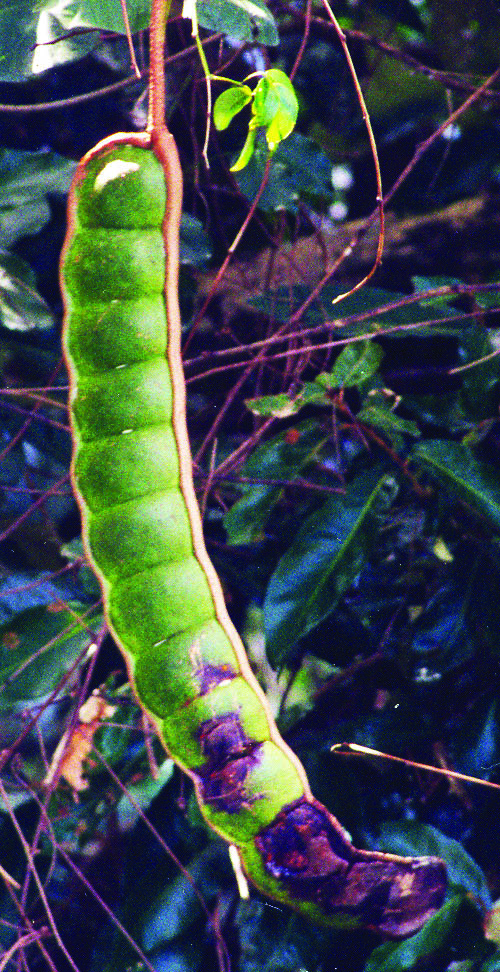
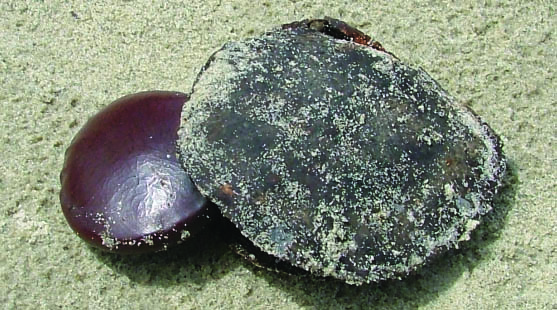
Sophora tormentosa ‘Silver Bean’. Shrub. Distinctive leaves; they are compound with up to a dozen or more small, round almost silvery leaflets. Yellow pea-like flowers. Silver, velvet looking pods, with very narrow waists. Common on beaches around the tropics of the world.
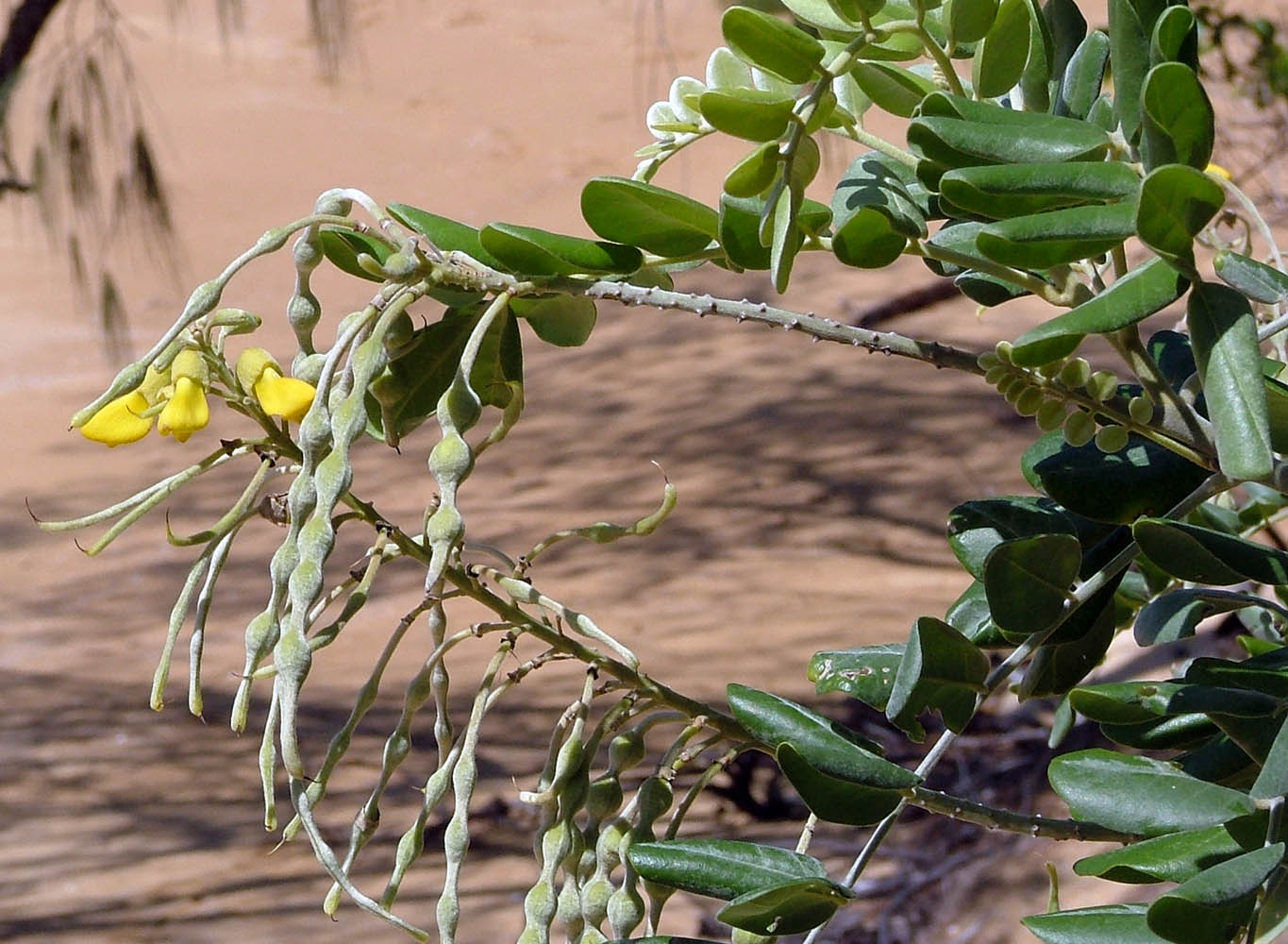
The genus Mucuna contains some 100 species throughout the tropics and subtropics of the world. Mucuna gigantea ‘Burny Bean’ ‘Velvet Bean’. Climber. Compound leaves of 3 leaflets. Unusual greenish-white flowers that hang down. Large hanging pods, covered in irritating hairs Seeds are ‘rounded square’ in shape, shiny, black, and dented. Famous amongst children in north-east because if you rub bean quickly on clothing, gets hot enough to hurt your victim! Seed is sometimes found washed up along beaches. Found in forest and on seashore across tropical Australia, New Guinea, into Asia. The tree Intsia bijuga, ‘Kwila’ has similar seed, but it tends to be heart-shaped, smoother, and duller.
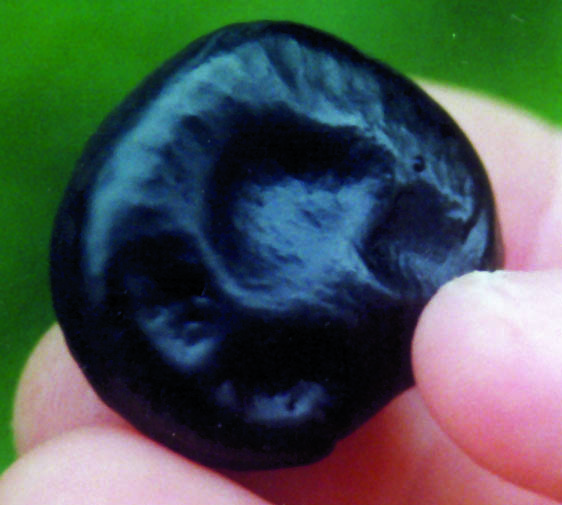
Canavalia rosea, ‘Sea Bean’. Prostrate crawler (no, not a prostate crawler). Alternate compound leaves made up of three (trifoliate) round leaflets. Bright pink pea flowers. Green pea-like seed pod. Along with the 'Goats Foot Ipomea', this is one of the most common creepers along the sandy tropical shores of Australia. Found throughout the tropical Indo-Pacific. There is another very similar plant called Vigna marina distinguished by its yellow flowers, rather than pink.
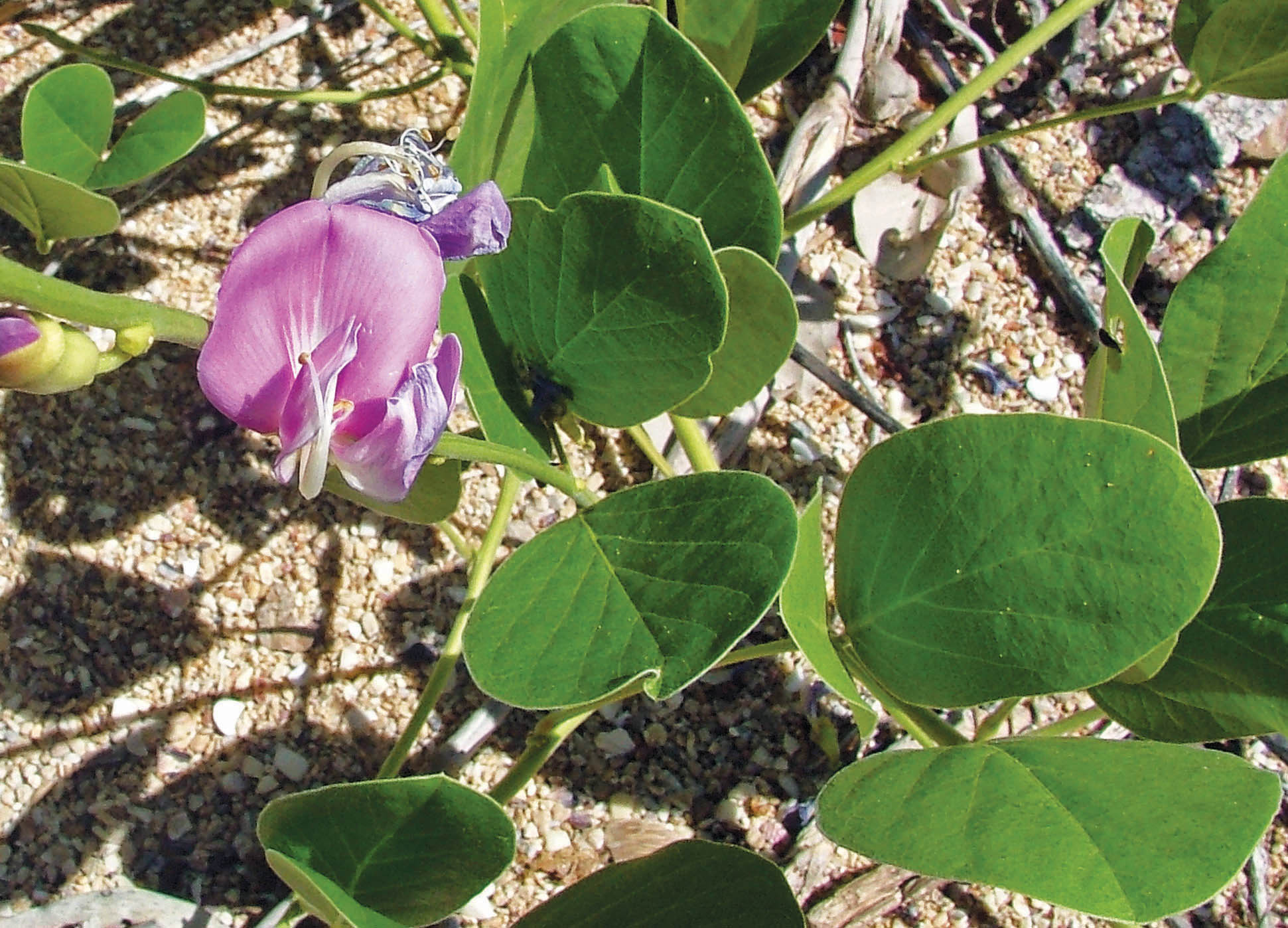 (KImberley coast, Australia)
(KImberley coast, Australia)The family Casuarinaceae contains the ‘she-oaks’, a group confined mainly to sandy soils across Australia, from rivers to woodlands to deserts. However, there are a couple of much more widespread species that are found on tropical beaches. Casuarinas usually grow as trees or large shrubs. They are wispy trees that often provide what little shade there is along some of the hotter, more exposed tropical seashores. When the wind blows through their foliage they produce a wonderful sigh that is perfect to lay down under on a tropical day. This foliage is made up of many drooping, almost pine-like ‘leaves’. These in fact are not the leaves, but branchlets. The true leaves are virtually unnoticeable, being tiny and scale-like, and found at regular intervals along the stems.
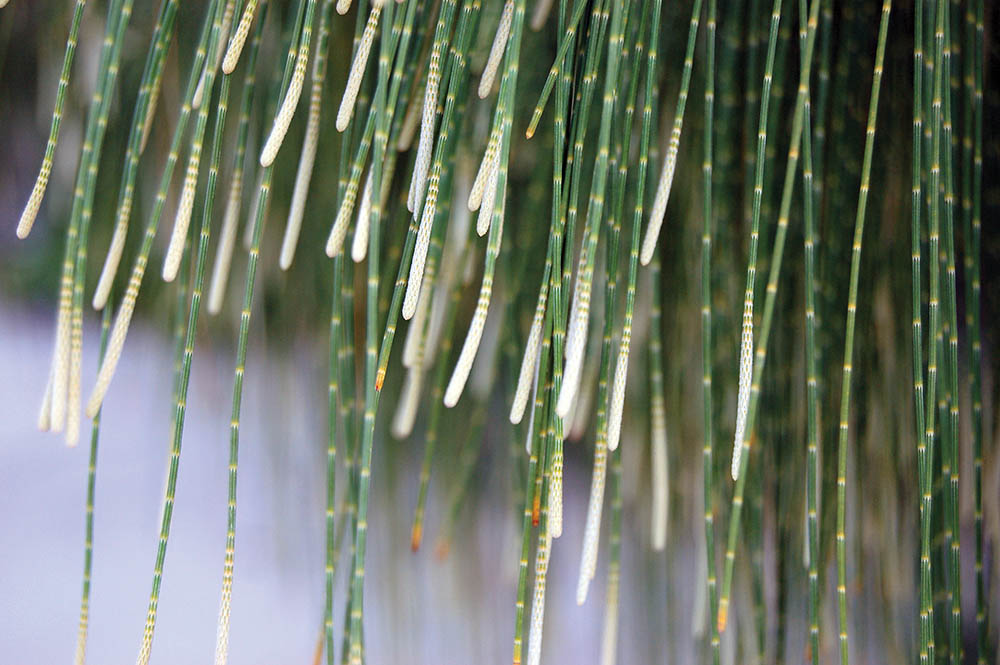
The most common species on Indo-Pacific beaches and a symbol of sandy coasts is Casuarina equisetifolia, ‘Beach Casuarina’, ‘Coastal She-oak’. It grows to a large tree and is often one of the first trees to colonize the sandy beach. This is the most widespread species of Casuarina, being found along tropical coastlines around Australia, through South-east Asia, and out into the Pacific. The flowers are tiny. The male flowers are usually produced at the end of the main branchlets, while the slightly larger reddish female flowers are produced along the side of the branchlets. They are followed by small, spiky, hard fruits.
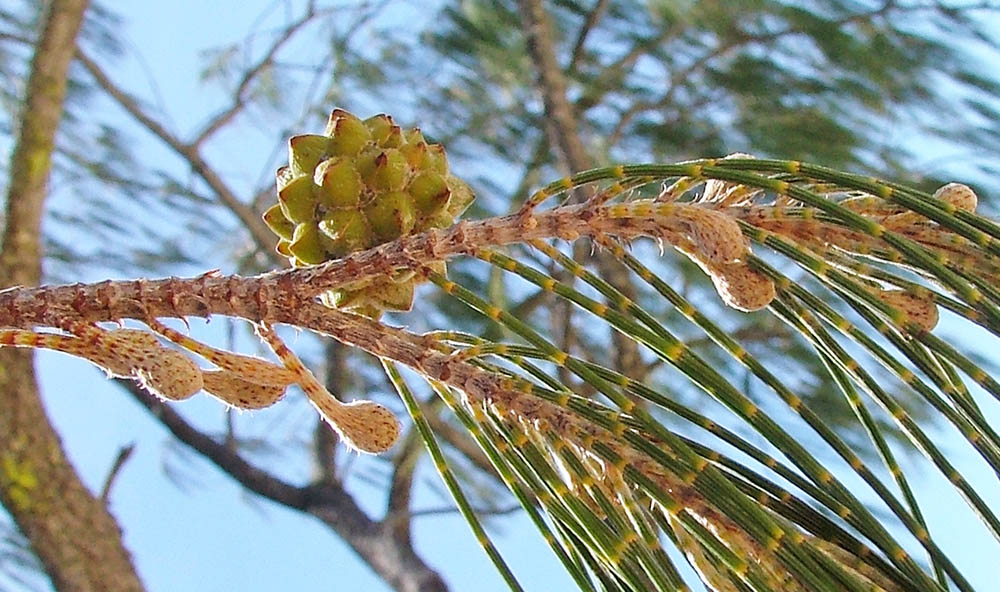
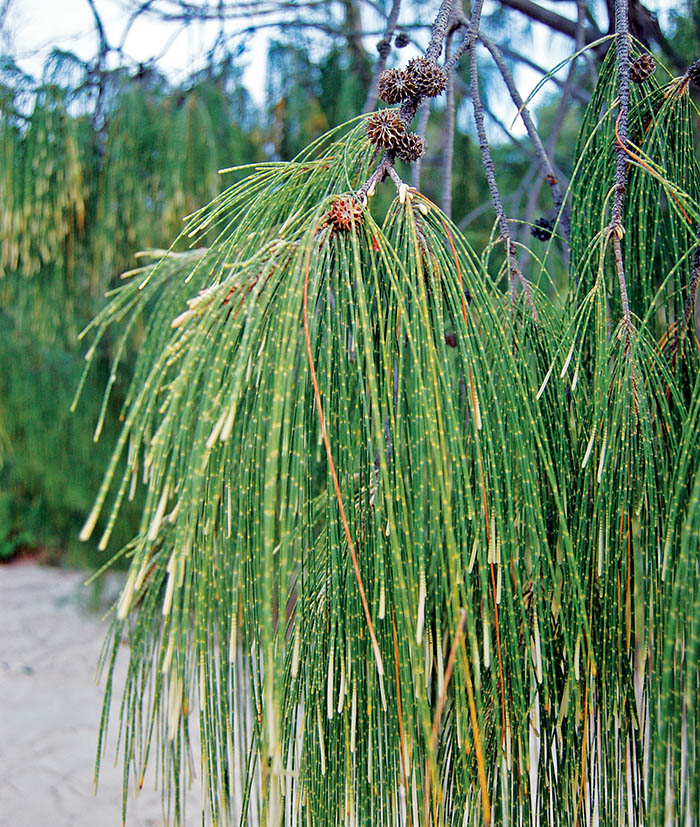
The genus Terminalia has more than 200 species found throughout the tropics of the world. Terminalia catappa, ‘Beach Almond’ is the most obvious coastal species. Wide tree, with layered ‘pagoda’ branches. Large leaves, widening at end, and growing from end of branch. Deciduous: leaves go red before falling off, and there are usually many bright red leaves present. Cream flowers on a spike. Large, canoe-shaped fruits ripen from green to blue-purple. Often seen littering ground along tropical coasts. Occurs naturally along tropical coasts of Australia and Asia. Locally, the wide canopy and large leaves provide much better shade than the wispy Casuarinas and thin leaves of Paperbarks that share the same habitat; so it has been planted extensively along coasts all around the world.
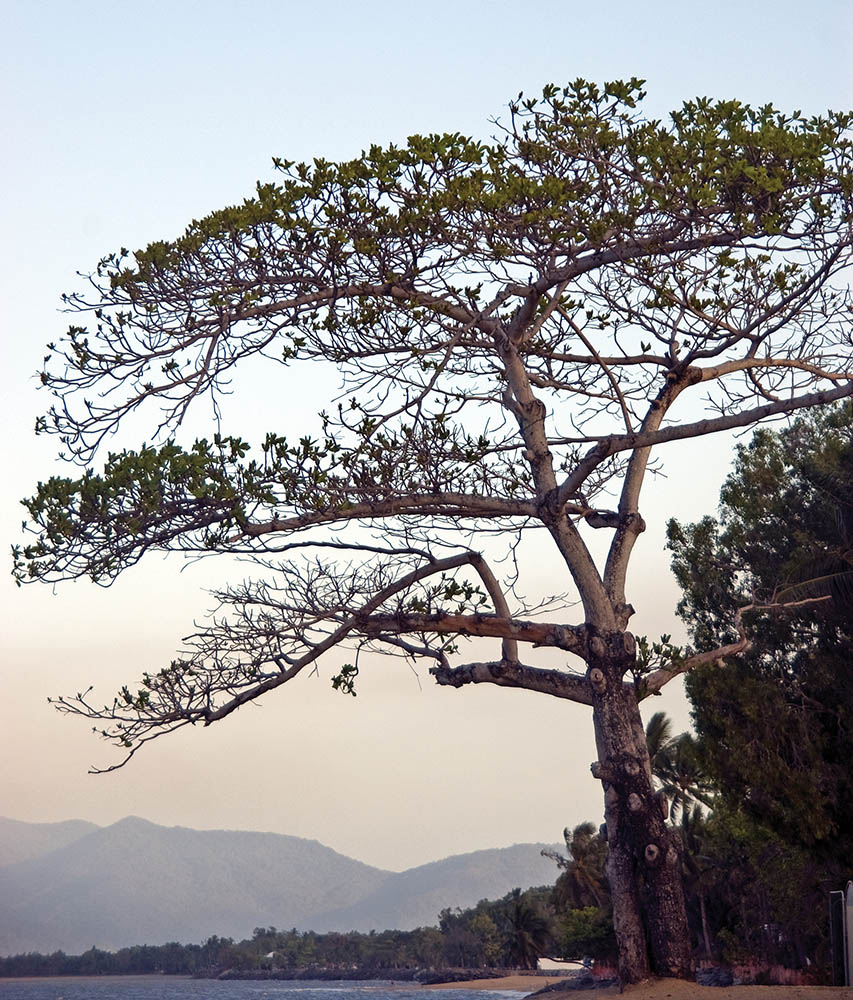
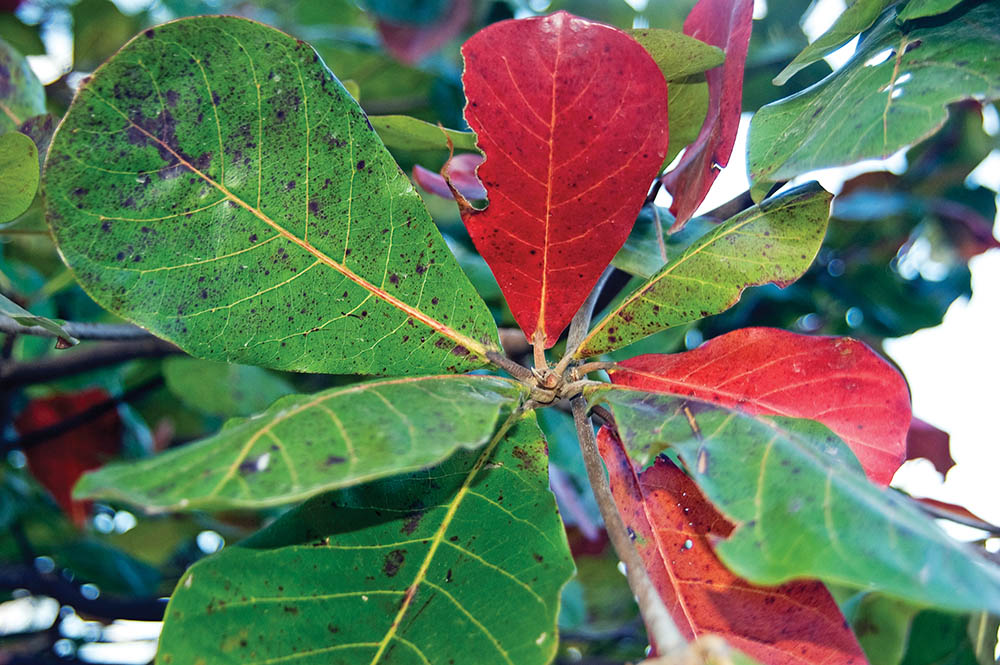
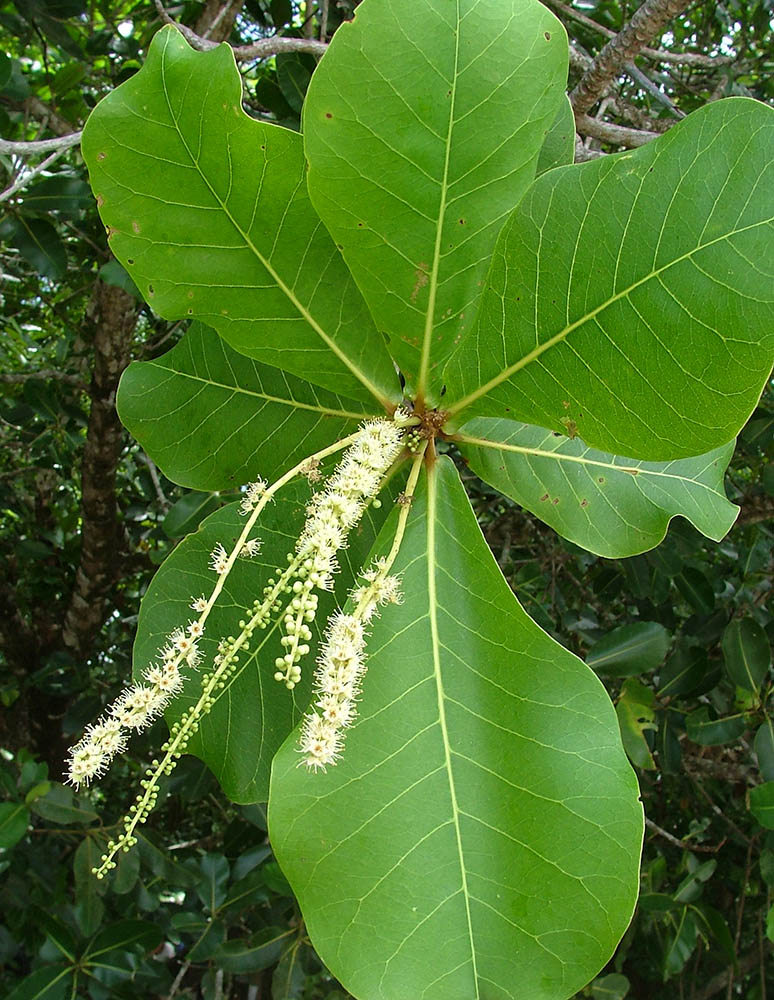
 Fruits of Terminalia (Cairns, Australia)
Fruits of Terminalia (Cairns, Australia)There are over 1000 species traditionally placed in the family Malvaceae, but as it now includes the previous families Sterculiaceae, Tiliaceae and others, it has two or three times that number. The most well known species in the original family are the cotton bush and the garden ‘Hibiscus’. The two following similar looking species are among the most common plants along the tropical Australian seashore: Thespesia populnea andHibiscus tiliaceus. Both species occur in the same beachside habitat, and have similar heart shaped leaves and large flowers with overlapping petals. However, leaves of the Hibiscus are paler underneath and much more developed lobes, and the flowers have protruding red tips from the top of the central column, which Thespesia lacks.
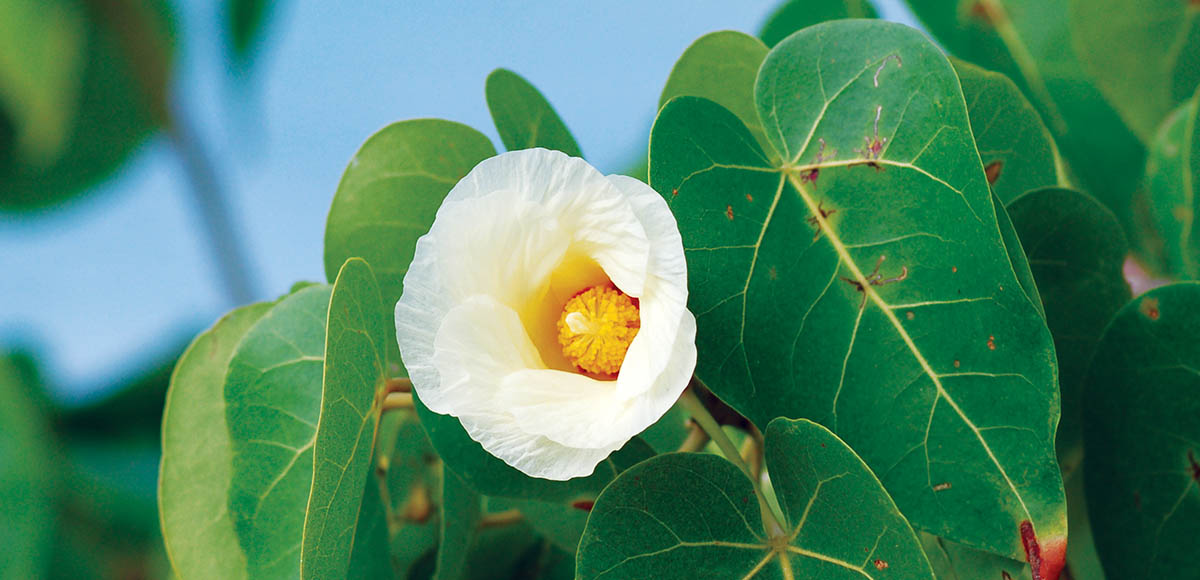 Thespesia populneoides, (Australia)
Thespesia populneoides, (Australia)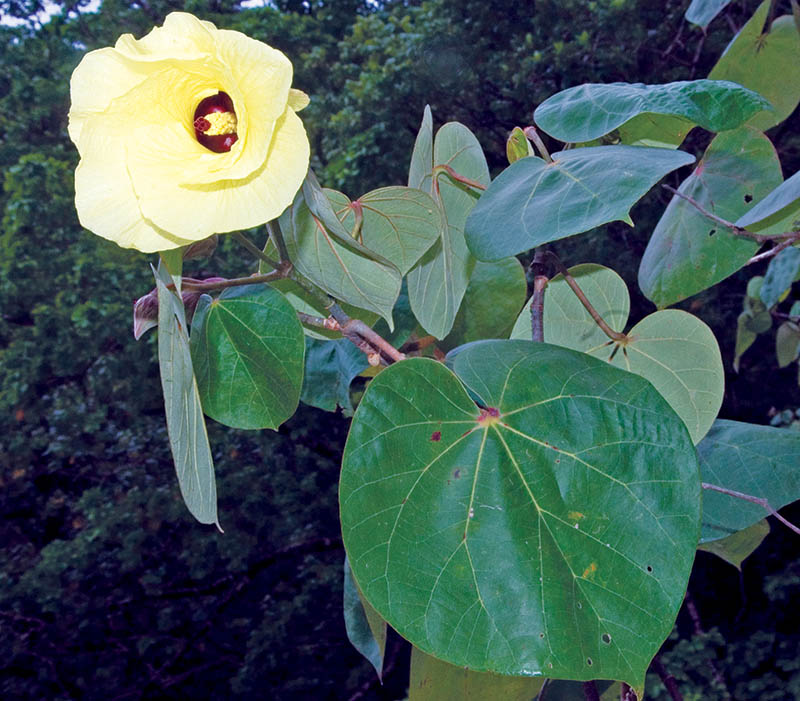 Hibiscus tiliaceus, (Cape Tribulation, Australia)
Hibiscus tiliaceus, (Cape Tribulation, Australia)The family Nyctaginaceae contains almost 300 species, found mainly around the tropics of the world. It’s most famous member is the Bougainvillea. It also includes the genus Pisonia which contains over 20 species found throughout the tropics of the world. The fruits in these plants produce exudate, and thus stick to animals to aid dispersal. This results in a strange ‘relationship’ between the some coastal species and seabirds. Birds such as Black Noddies nest in the branches of Pisonia trees, using the large leaves as nesting material. But they may become covered in the sticky fruits, which aids the tree in dispersing its seeds; however, the bird may get so stuck it can’t fly. It is thought the dying bird then provides some nutrients for the seedling to grow within. These bizarre circumstances gives rise to various names such as ‘Bird-trapping tree’ or ‘Bird Lime Tree’.
 (Lady Musgrave Island)
(Lady Musgrave Island)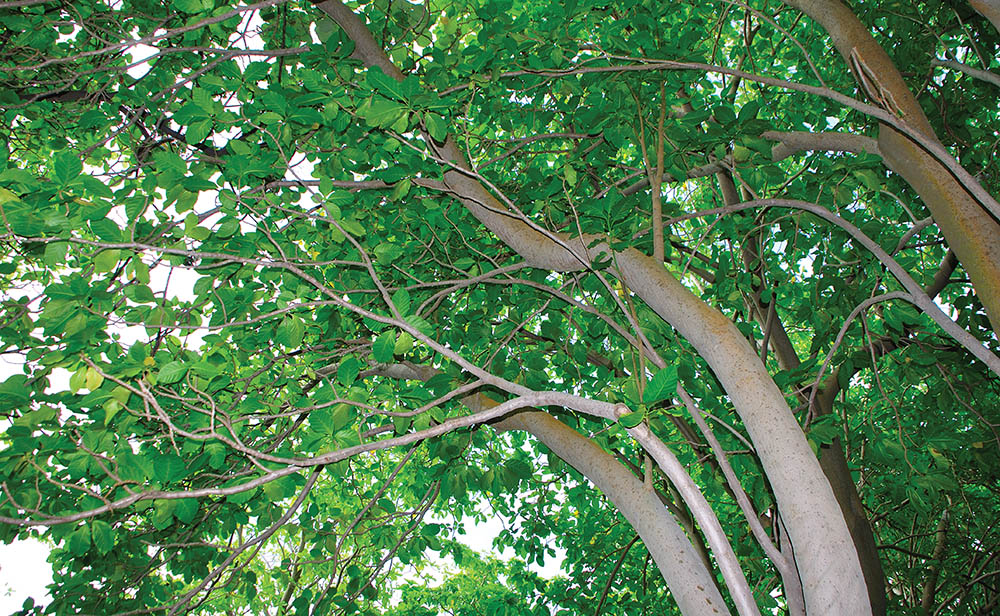 (Papua New Guinea)
(Papua New Guinea)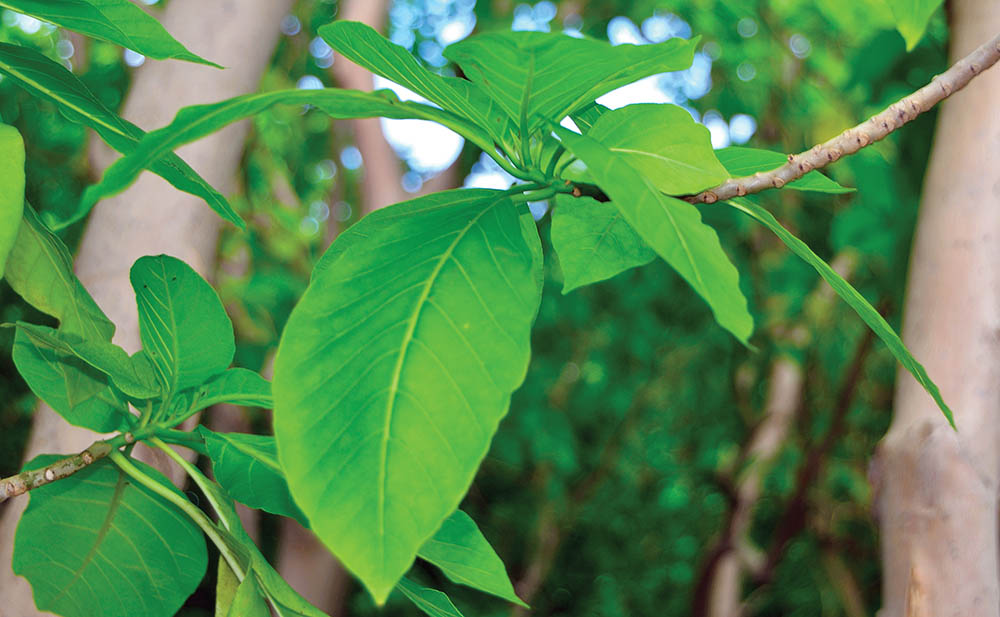 (Papua New Guinea)
(Papua New Guinea)Many of the species in the family Lecythidaceae fruit into hard capsules that contain seeds, as in the most famous member of this family, the ‘Brazil Nut’. The genus Barringtonia has about 40 different plants found throughout the tropical Indo- Pacific region. The plants usually have large simple leaves that are clustered at the end of the branches. The flowers are often spectacular: large sprays of stamens, sometimes hanging down in racemes. The following fruits vary; they can be either fleshy or, if dispersed by fresh or salt water, large and woody. Barringtonia asiatica ‘Beach Barringtonia’, 'Fish Poison Tree', 'Box Fruit', 'Futu'. Usually short, but often wide spreading, tree. Large rounded leaves in whorl at end of branches that are typical of genus. Produce large upright flowers, many long cream stamens with pink ends. Flowers drop during day. Followed by very large woody, angular fruits, usually four ridges, sometimes five. Fruits ripen from green to brown, may be found on at either stage. The fruits and buoyant and can float for many years, and they are used as fishing floats. Once they wash ashore, and are soaked by freshwater, they germinate, thus they tend to colonize wetter tropical coasts. Widespread, being found in forest along wetter seashores throughout tropical Indo-Pacific. The local name Futu gave rise to the island name of Futuna. The seeds are ground down and used as a 'fish poison', the saponins inside interfering with the oxygen intake of fish and stunning them to the surface to be collected.
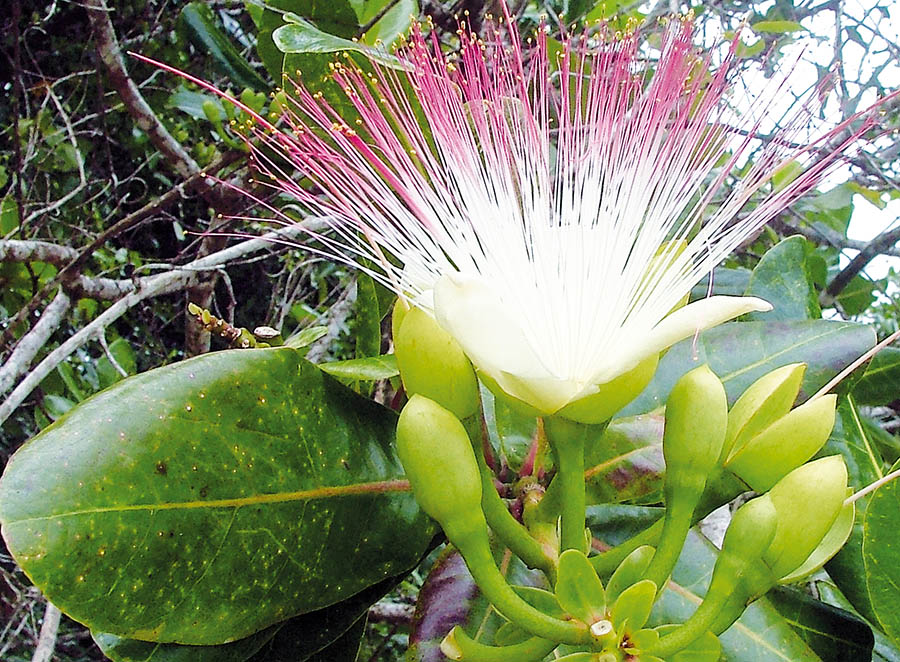
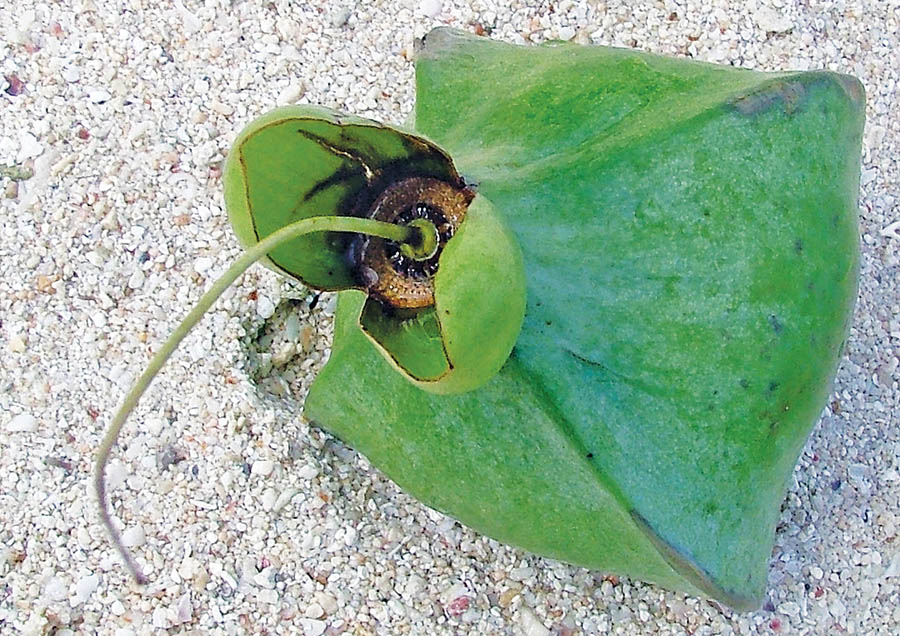
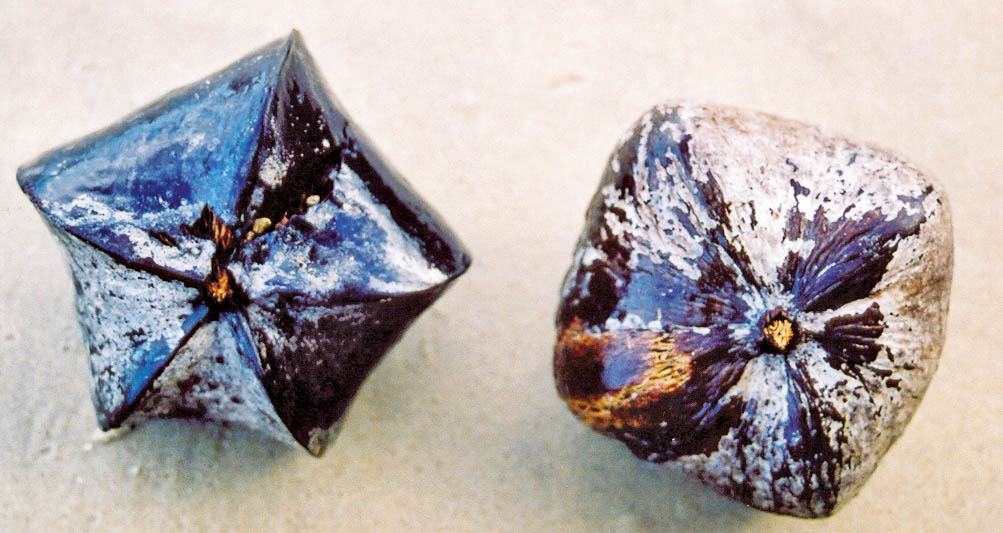
The family Rubiaceae is one of the largest of all flowering plant families with over 7000 species. They are found mostly in the tropics of the world, but are also represented in the subtropical and temperate regions. The leaves are usually either opposite to each other, or arranged in whorls. This family provides also provides another product that without which, this website would not have been written: coffee. One of the most distinctive groups along limestone rocky seashores is Bikkia. The flowers of this genus are distinctive in their almost square-like shape created by the four triangular petals fitting together. These plants are usually found growing on limestone along tropical seashores. The 10 or so species occur on islands in the western tropical Pacific.
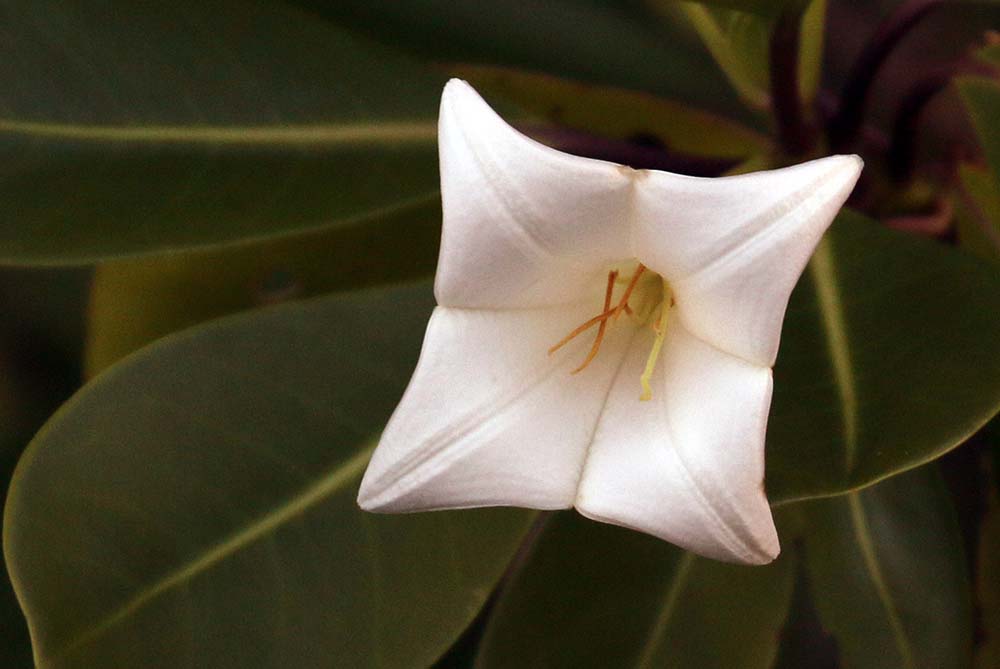 (Palau)
(Palau)There are about 80 species in this genus. They have a distribution across the tropics of the world. The genus was named after a French botanist, geologist and naturalist Guettard. One of the species is common in coastal scrub an forest: Guettarda speciosa ‘Sea Randia’, ‘Zebra Wood’. Short tree or shrub. Very large light green leaves with yellow venation, usually bunched at the end of branches. Develops small fragrant tubular white flowers in warmer months, these are followed in winter by hard, round, slightly flattened fruits with a persistent calyx represented by distinctive ring on top. Fruits remain green on the tree for some time before ripening to brown. Fruits are dispersed by the ocean, and when found on shores are often just a ball covered in matted threads.
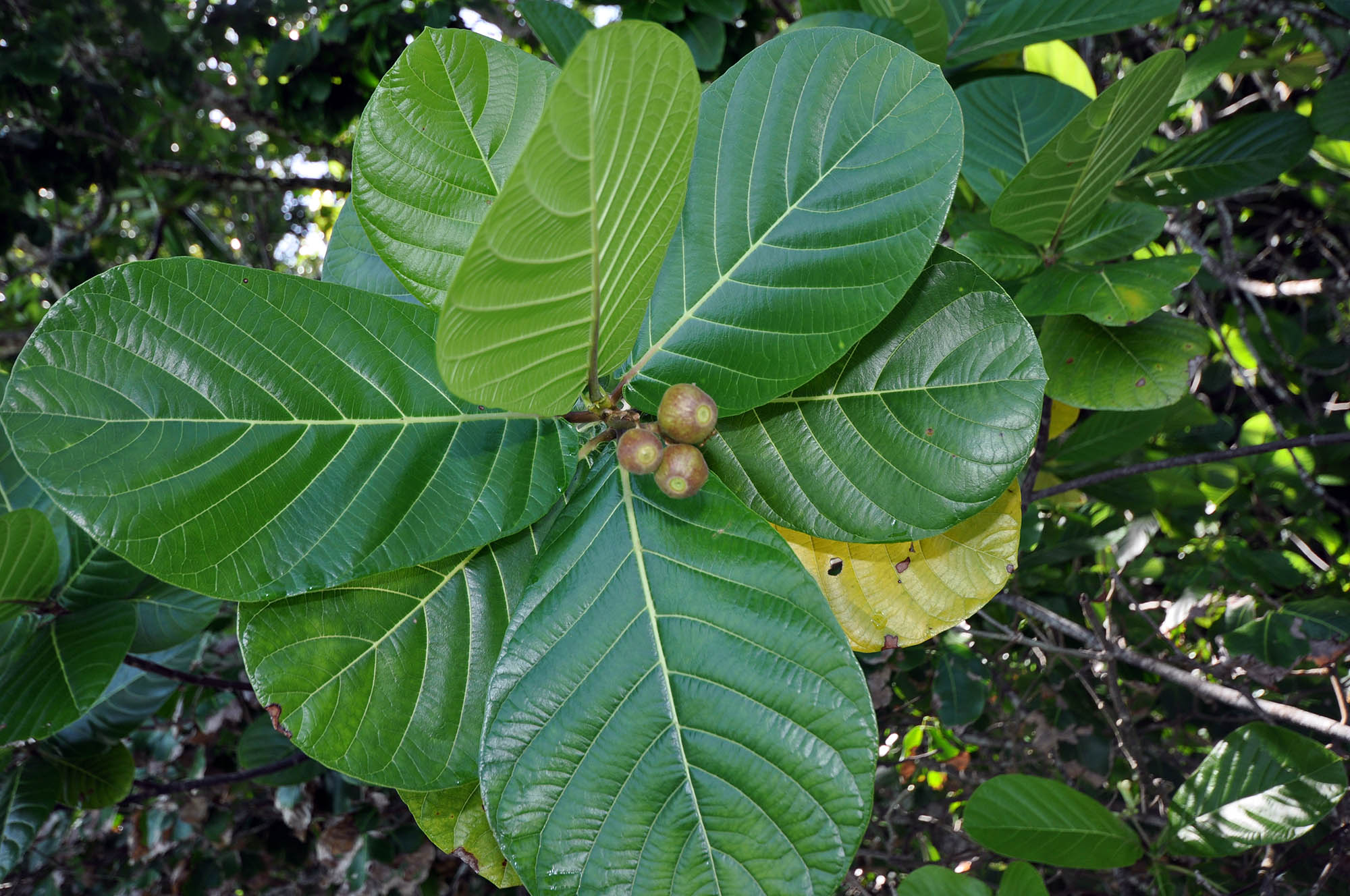 (Marovo Lagoon, Solomons)
(Marovo Lagoon, Solomons)Ipomea is a large genus with many introduced and native species. The leaves are usually heart shaped. Flowers can be white, red or orange, but the best known are blues and purples. They are normally deep tubular flowers with large spreading petals joined together to form the familiar ‘morning glory’ flower. Ipomea pes-caprae, ‘Goats Foot Morning Glory’ is one of most common plants of the tropical Indo-Pacific beach. It is a vine that crawls along beaches, across sand or rocks. The leaves are shaped like a hoof. It has large purple pink flowers.
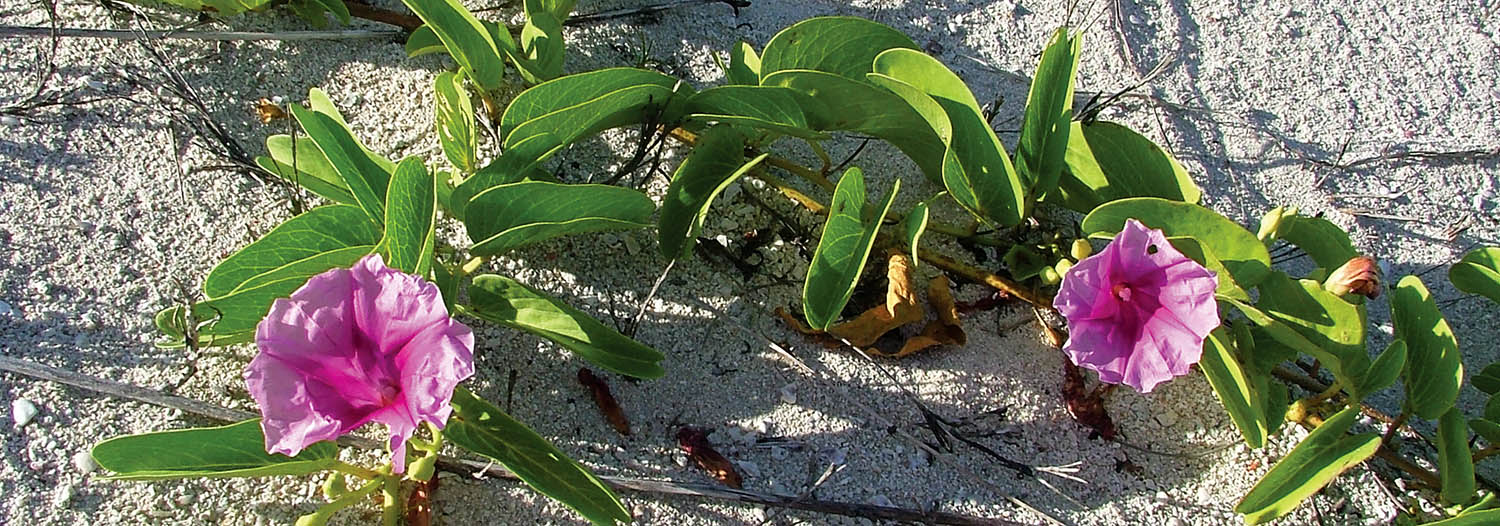 (Kimberley, Australia)
(Kimberley, Australia)Cordia subcordata ‘Trumpet tree’ grows as shrub or small tree. It has large, heart-shaped leaves slightly rough to touch. The flowers are attractive; orange, with six crinkled petals. .
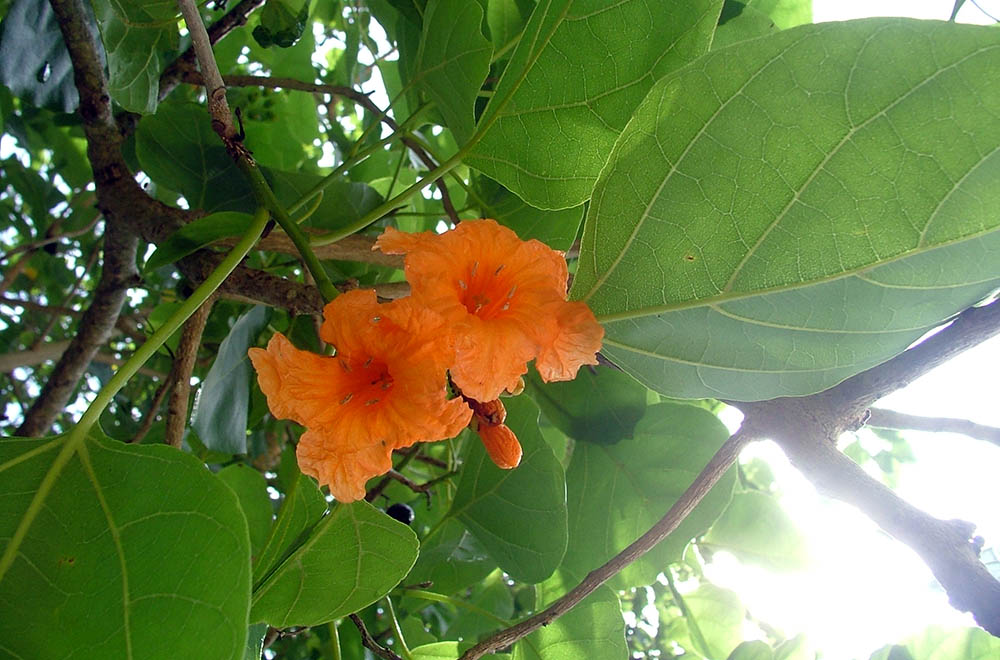 (Papua New Guinea)
(Papua New Guinea)Argusia (previously Tournefortia argentea/Messerschmidia) argentea ‘Octopus Bush’. Grows as shrub. Soft, silvery leaves. Large col- lections of small white flowers arranged in a tight cauliflower like head. A common shrub of the sandy coast throughout tropical Indo-Pacific.
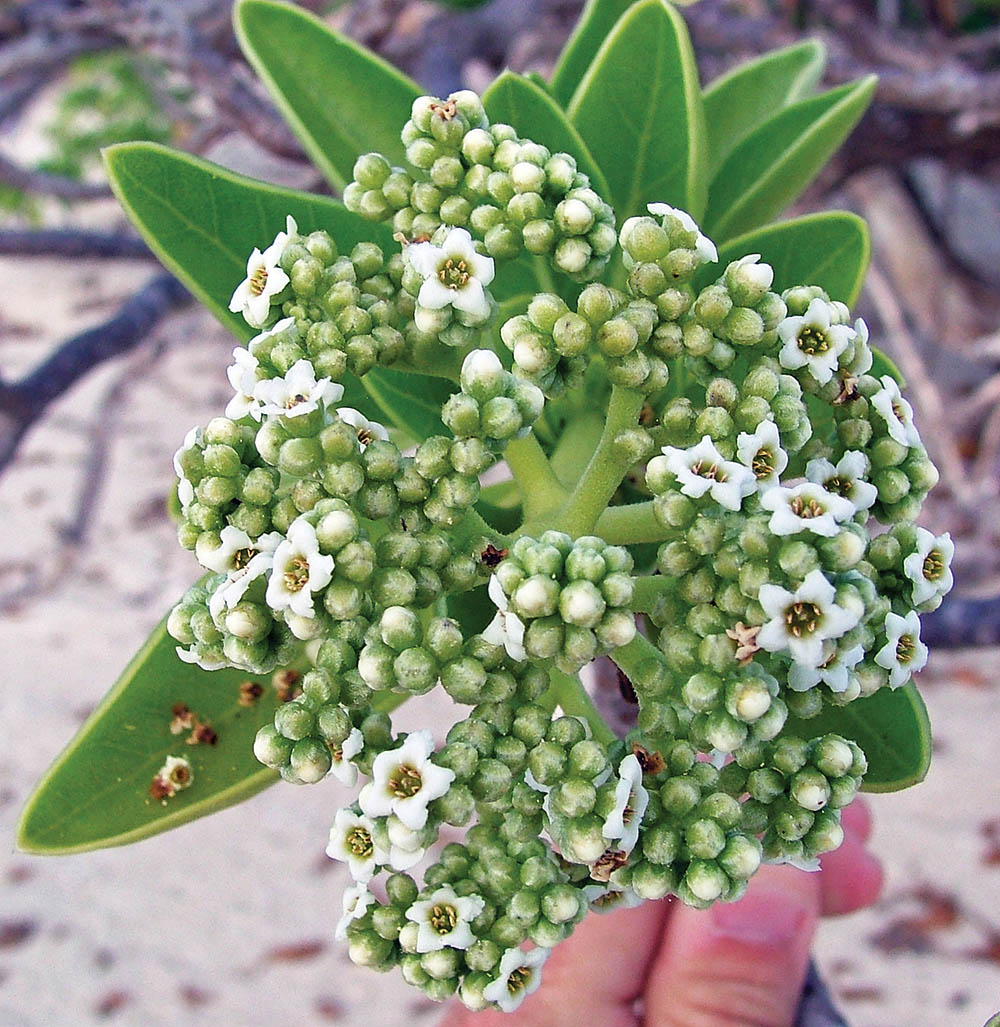 (Magra Island, Australia)
(Magra Island, Australia)The flowers in the genus Scaevola are unique, having the 5 petals on one side of the flower and not the other, with the name Scaevola meaning ‘left-handed’. This genus contains one of the most symbolic plants of the topical seashore: Scaevola taccada (formerly S. sericea), ‘Sea Lettuce’, ‘Cardwell Cabbage’, ‘Pipe Tree’ usually grows as a shrub or small tree. It has large, light green glossy leaves that widen to a rounded tip, and grow out spirally. The fllowers are white and slightly hairy, with five petals splayed out distinctly on one side of the flower. The following fruits are small, white and fleshy.
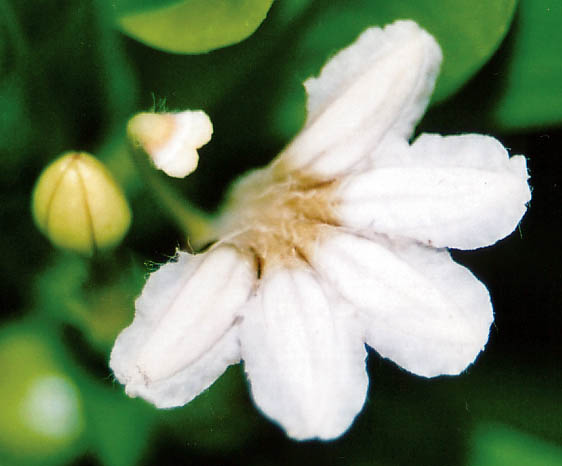
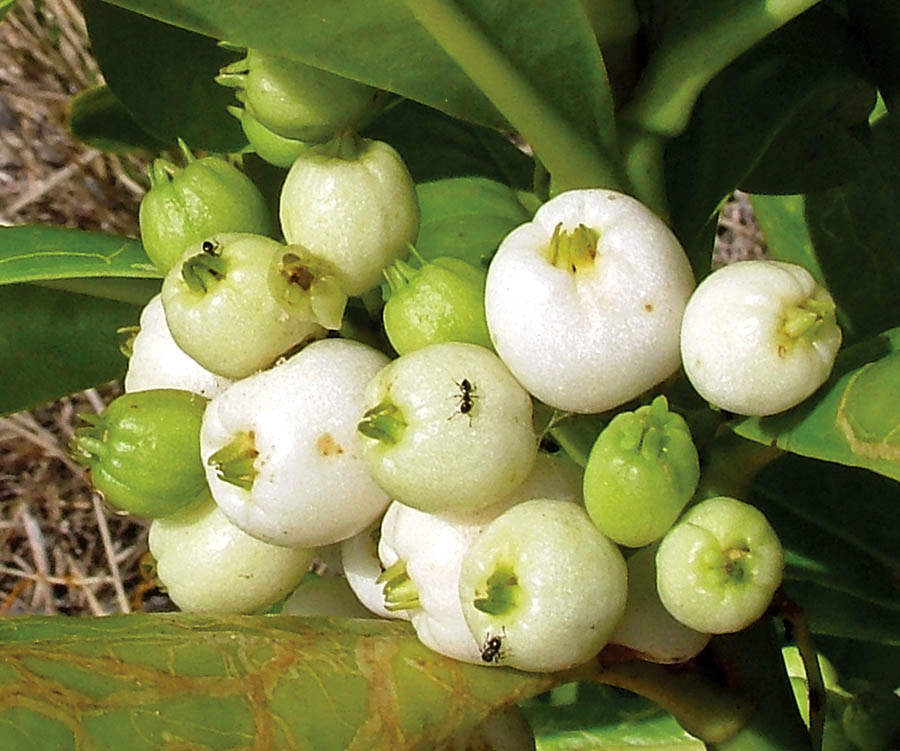 (Lizard Island, Australia)
(Lizard Island, Australia)For my lecture on driftseeds
The huge class Gastropoda includes all the 'Spiral' seashells that wash up or live on tropical seashores. These days we do not collect shells, and in fact there are some that one should avoid even picking uo. Many species of 'Cone Shell' in the family Conidae can injure a human, and some species can even kill. Below is the Conus textile, 'Cone Shell', one of the more dangerous. Most of the washed up cone shells are just dead remains and harmless, however it is wise to be cautious and "if it's shaped like a cone, leave it alone!".
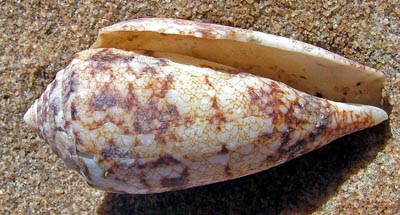
There are many other animals that look like gastropod seashalls, but are not related. The ‘forams’ are single-celled 'animals' that live mainly in marine habitats. They are mostly found on the seafloor, with some attaching to seaweeds, but some may float as part of the plankton. It produces a shell of calcium carbonate, much as mollusc seashells and many other unrelated marine animals do. This is called the test, and part of the body is inside the shell, and part is outside. In the context of the tropical seashore, they are usually only noticed when the hard remains of larger species are washed onto the beach. They can be very common in certain areas, but because they are small, they generally go unnoticed. In some areas of ocean floor and even some tropical beaches, their remains constitute most of the sediment. Their shells have a range of different shapes, but the more commonly seen larger ones are usually circular. Species of Marginpora can be up to a centimetre or more in size and be common in tropical beach sand. They often have the middle worn away first, leaving a small hole. These shells are then made into necklaces.
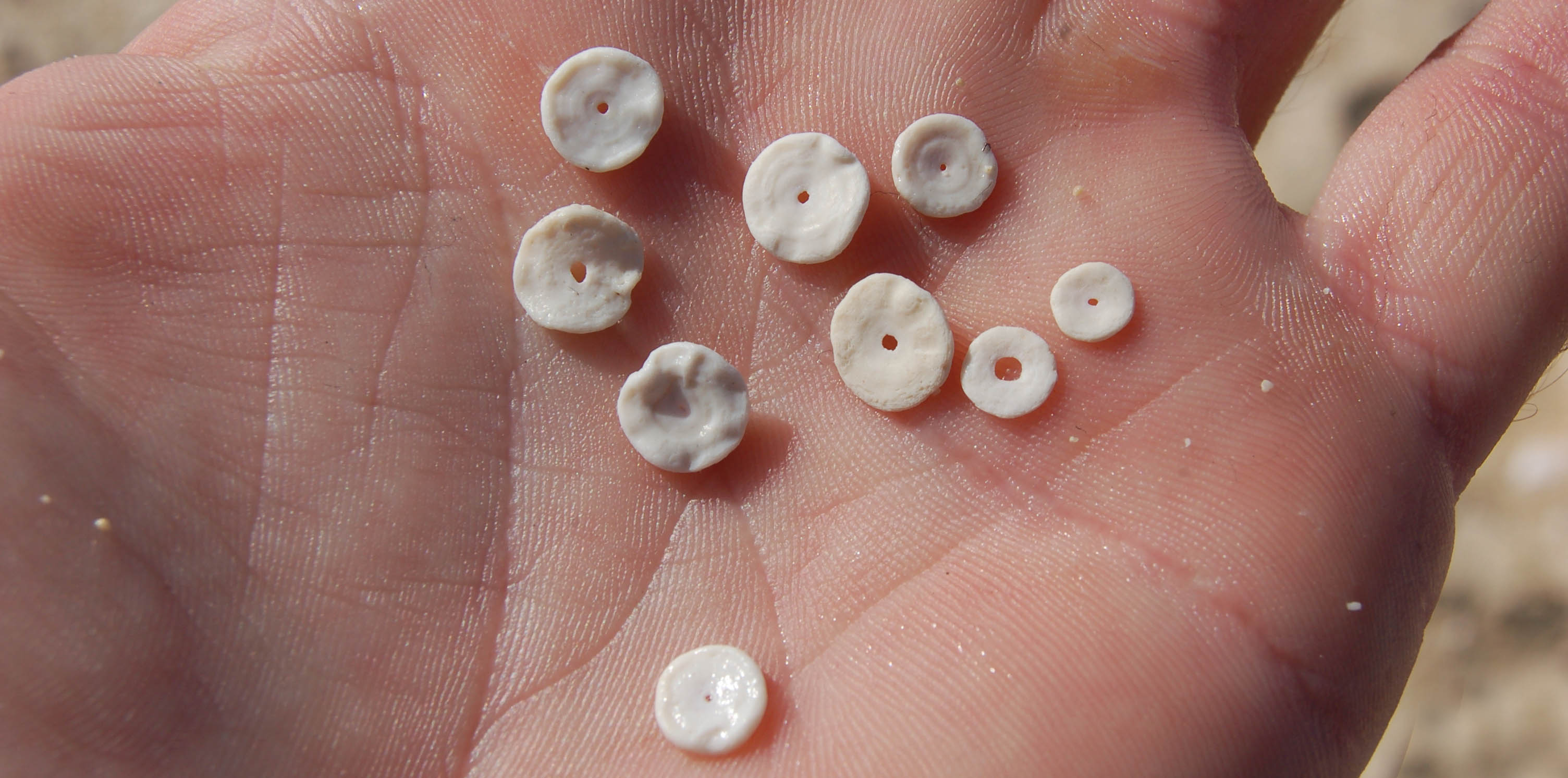
‘Ghost crabs’ are medium-sized crabs that are usually sandy coloured to blend in with their favoured habitats. They are evidenced in an area by their large round burrows in the sand. They are only occasionally seen during the day, They are more nocturnal in habit, and can often be seen on tropical shores at night by torchlight. When seen, they can run sideways along the sand at incredible speed, and will often run into the waves or into their burrow. They are scavengers and predators, including feeding on turtle hatchlings and other crabs.
 'Golden Ghost Crab', (West Australia)
'Golden Ghost Crab', (West Australia)The largest crustacean on tropical seashores, indeed, the largest crab on land, and the in fact, the largest invertebrate on land anywhere, is: Birgus latro, 'Coconut Crab', 'Robber Crab'. The largest land invertebrate on the planet! Today, they are only normally found on islands where there are no people.
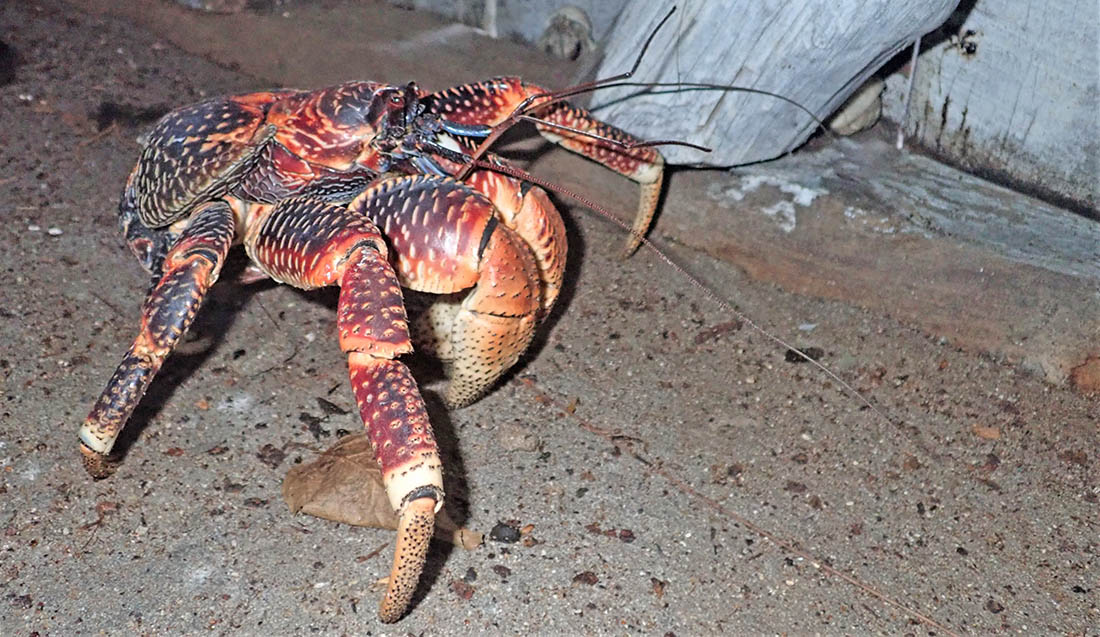 (Seychelles)
(Seychelles)Various rays can be seen in the shallow water along tropical shorelines. Glaucostegus typus, 'Common Shovelnose Ray'. Often seen snuffling around in murky shallows. When in shallow water, their distinctive arrangement of fins can be seen, with three fins following each other, two located far back along the body, and the tail tip. This species was apparently the first type of shark/ray that was proven to see in colour.

The superfamily Chelonioidea includes all the 'Marine Turtles'. The females of these reptiles need to come ashore to dig their nests and lay their eggs. About a month later (depending on the species), hatchlings will dig their way out. Below is a fresh hatchling of Eretmochelys imbricata, 'Hawksbill Turtle'.
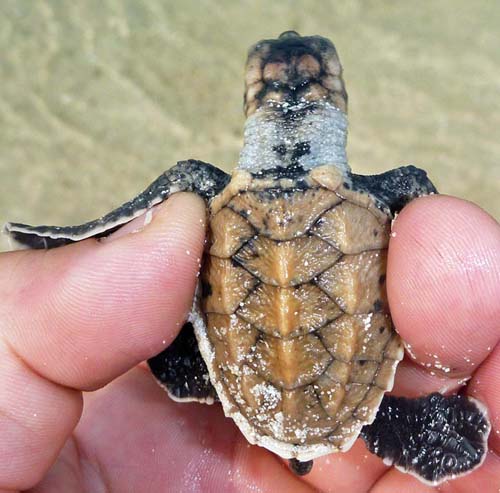 (Arnavon Islands, Solomons)
(Arnavon Islands, Solomons)The family Elapidae contains many infamous venomous snakes, such as Cobra and Taipan. The family also includes Laticauda spp., 'Sea Kraits'; these snakes live most of their lives in the sea, but unlike the 'true sea snakes', they come ashore to rest, digest, and breed.
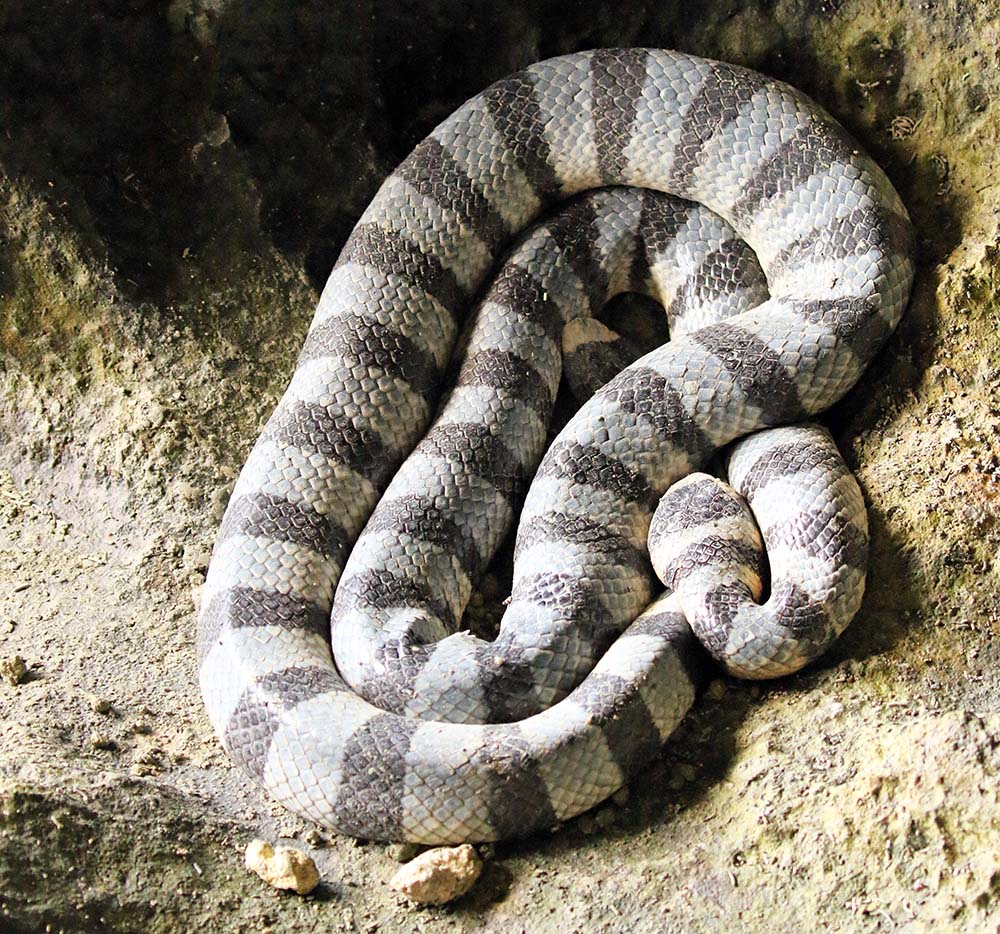 (Palau)
(Palau)There are over 10,000 species of birds in the world, and they have successfully established themselves in almost every ecosystem all over the planet, including the most remote coasts and smallest sand islands, where there is little other large land based life. This habitat serves different purposes for different types of birds at different times of their lives. For example; the more marine based birds, such as boobies and terns, are found on the tropical seashores in their greatest numbers when breeding, whereas the waders mostly breed out of the region and use the tropical seashores to feed. Unlike most of the vertebrates, there are even many species that specialize along the tropical seashore. They are not only one of the most abundant groups of animal along the tropical seashore, but with their flight, feeding and behaviour, they are one of the most fascinating.
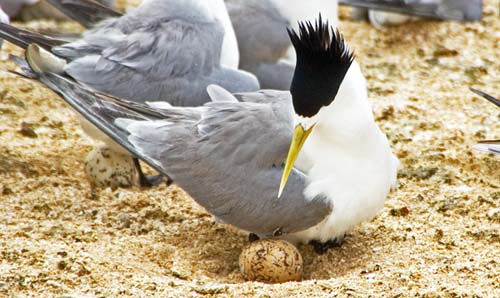
Below is Arenaria interpres, 'Ruddy Turnstone'. Widespread throughout most of the coasts of the world.
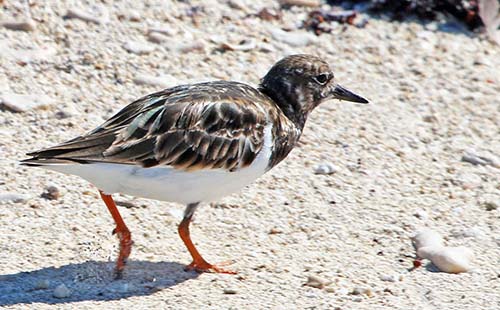 (Lacepede Islands, Western Australia)
(Lacepede Islands, Western Australia)The terns are the most diverse group of birds likely to be seen along the more remote tropical seashores. They typically pick coasts that are inaccessible to land predators, and usually breed in pairs that are monogamous for the season.
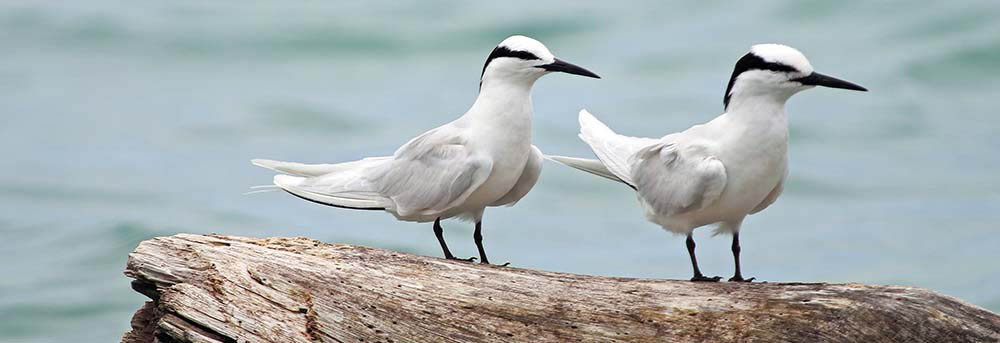
The many widespread species include:
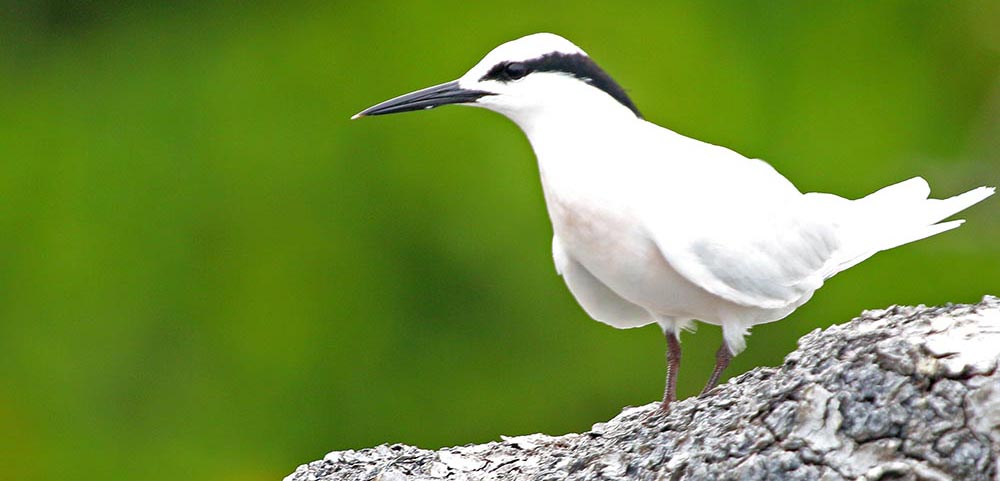 'Black-naped Tern', (Alim Island, Papua New Guinea)
'Black-naped Tern', (Alim Island, Papua New Guinea)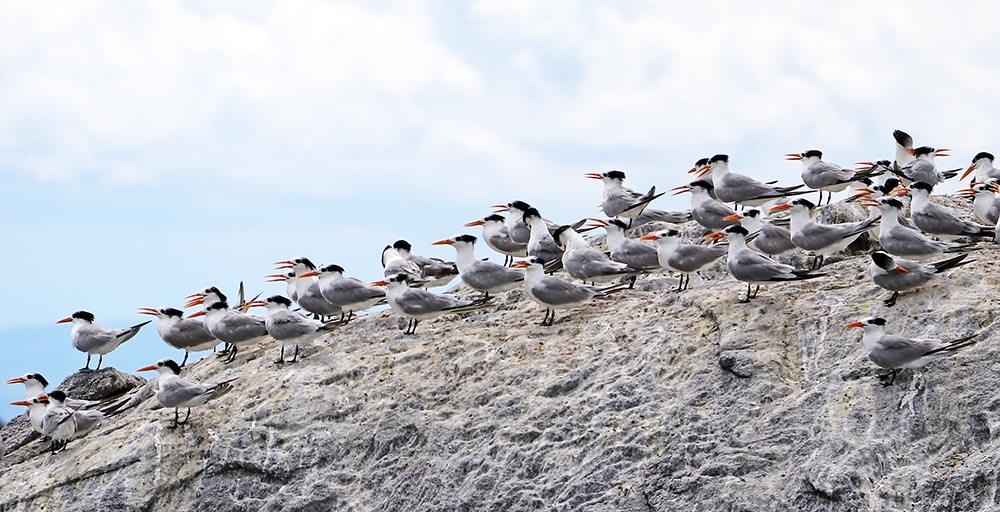 'Lesser Crested Tern', (Madagascar)
'Lesser Crested Tern', (Madagascar)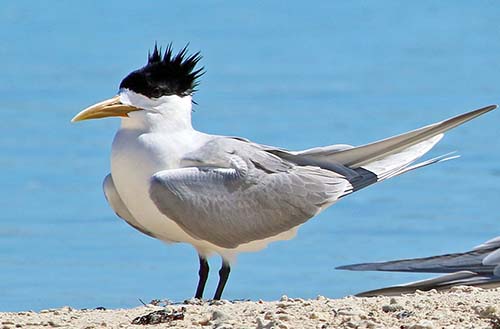 'Crested Tern', (Lacepede Islands, Australia)
'Crested Tern', (Lacepede Islands, Australia)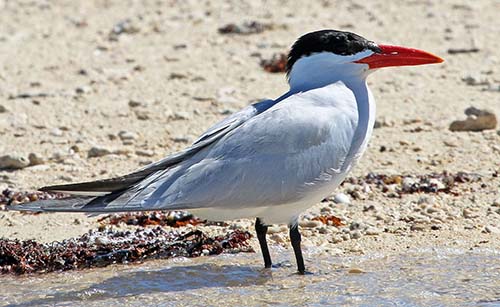 'Caspian Tern', (Lacepede Islands, Australia)
'Caspian Tern', (Lacepede Islands, Australia)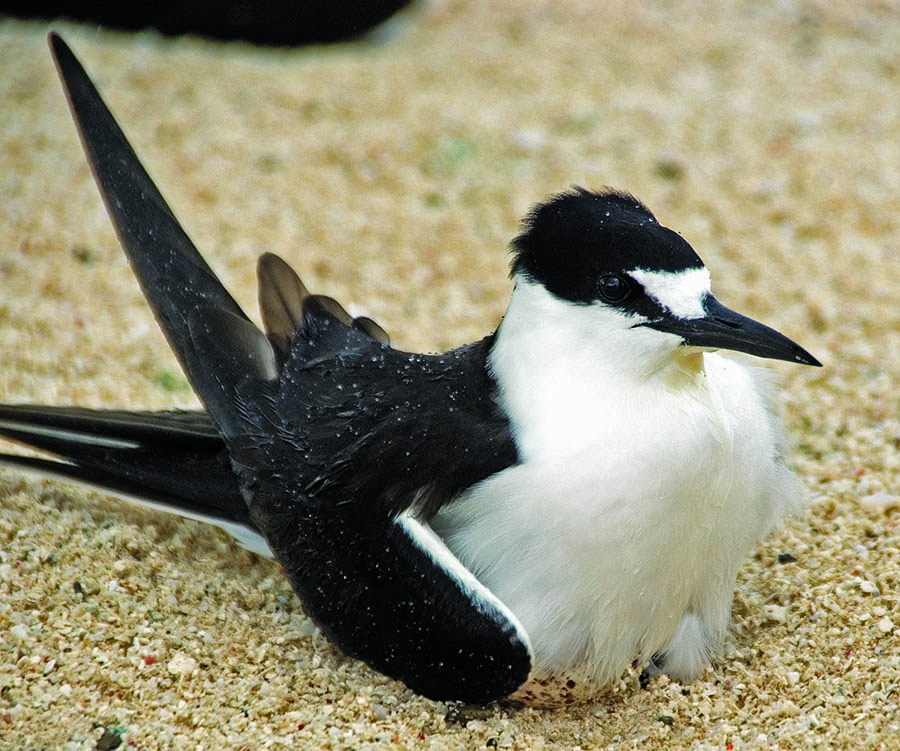 'Sooty Tern', 'Wide-a-awake Tern', (Michalemas Cay, Australia).
'Sooty Tern', 'Wide-a-awake Tern', (Michalemas Cay, Australia).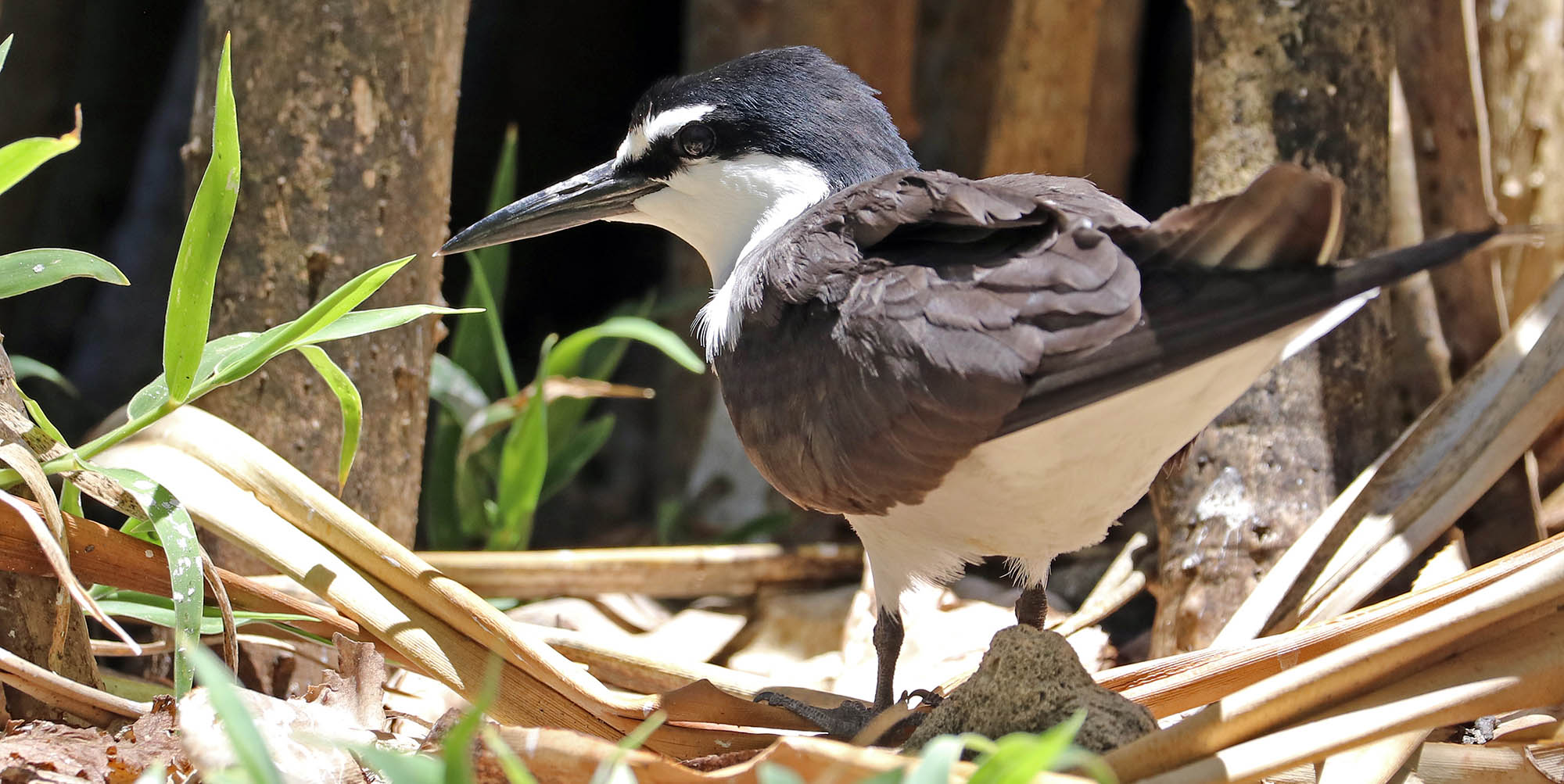 'Bridled Tern', (Lady Musgrave Island)
'Bridled Tern', (Lady Musgrave Island)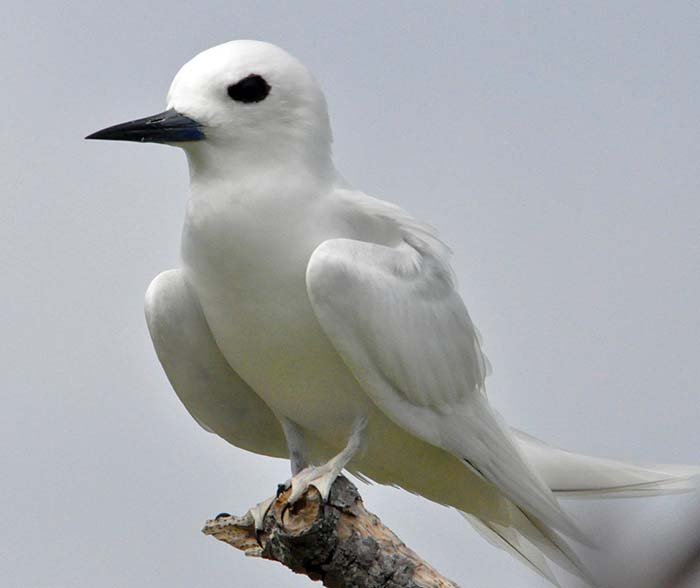 'White Tern', (Ducie Atoll, Pitcairn Islands)
'White Tern', (Ducie Atoll, Pitcairn Islands)Noddys are terns with the colours reversed; instead of being white with a dark cap, they are dark with a light cap. They have stronger feet and legs, and broader wings than many other terns. These broader, gull-like wings are used to glide more than other terns. Unlike most other terns, rather than diving into the water to catch prey, they skim through the surface of the water and, like gulls, they are often seen sitting on the surface of the water. When resting from feeding and flying, they have been recorded to perch on sea turtles and even pelicans.
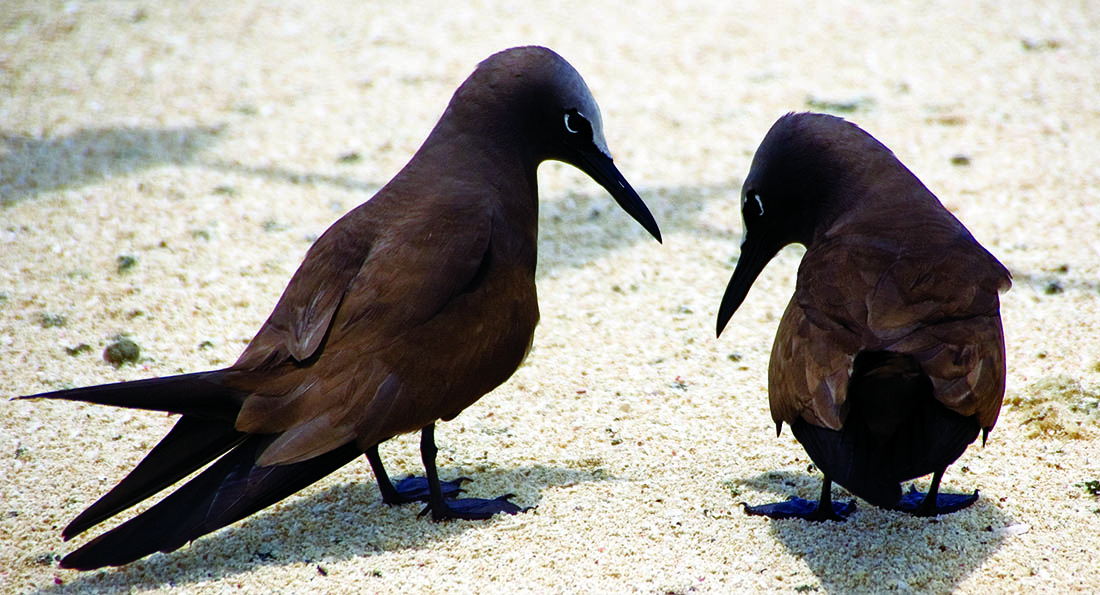 A pair of noddies, nodding.
A pair of noddies, nodding.The family Phaethonitidae is comprised of the Tropicbirds.
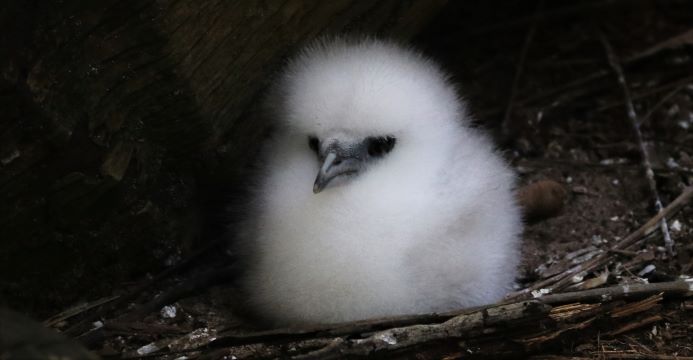
The family Sulidae includes all the Boobies (and temperate Gannets).
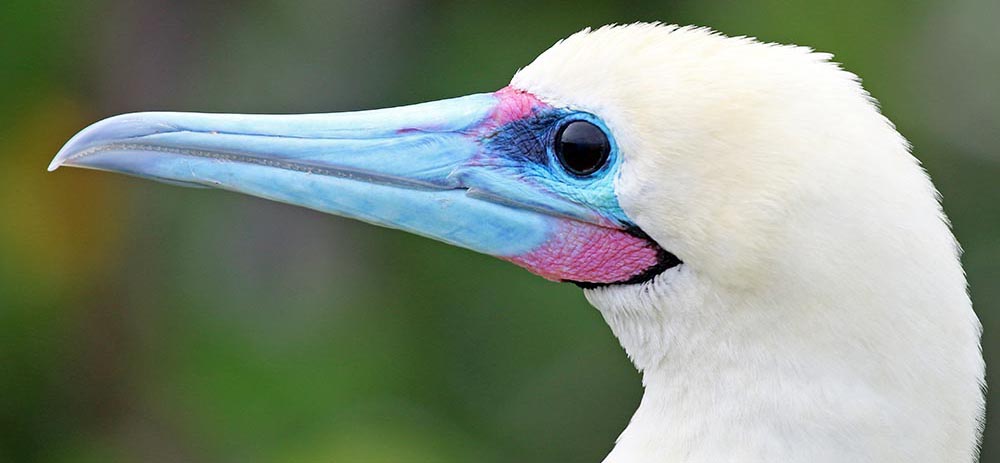 'Red-footed Booby', (Alim Island, Papua New Guinea)
'Red-footed Booby', (Alim Island, Papua New Guinea)The family Ardeidae contains all of the Herons, Egrets, Bitterns. below is the widespread Eastern Reef Egret.
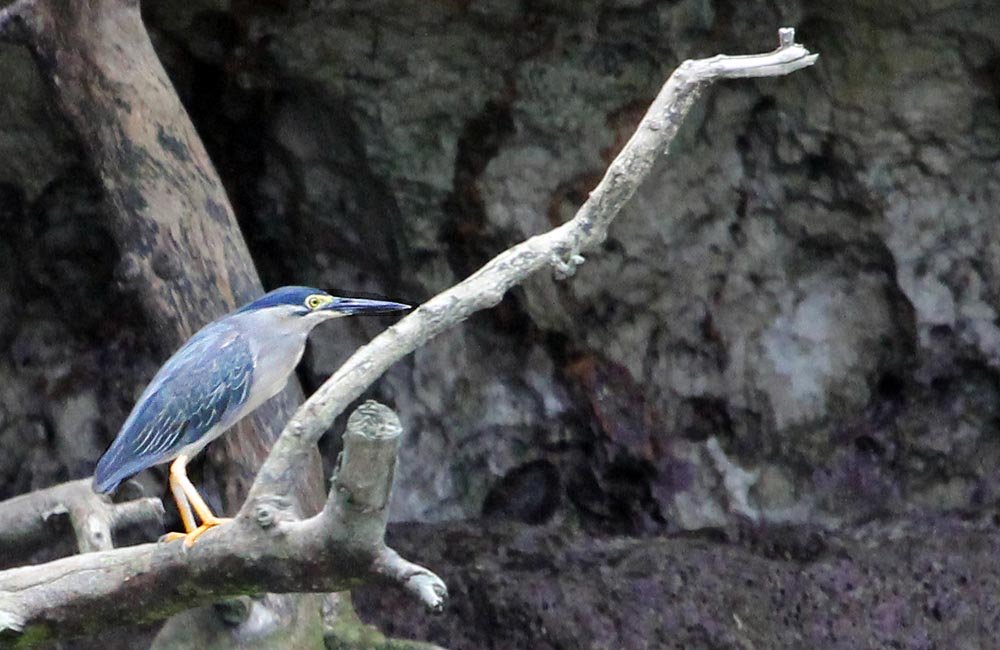 'Mangrove/Striated Heron', (Misool, Indonesia)
'Mangrove/Striated Heron', (Misool, Indonesia)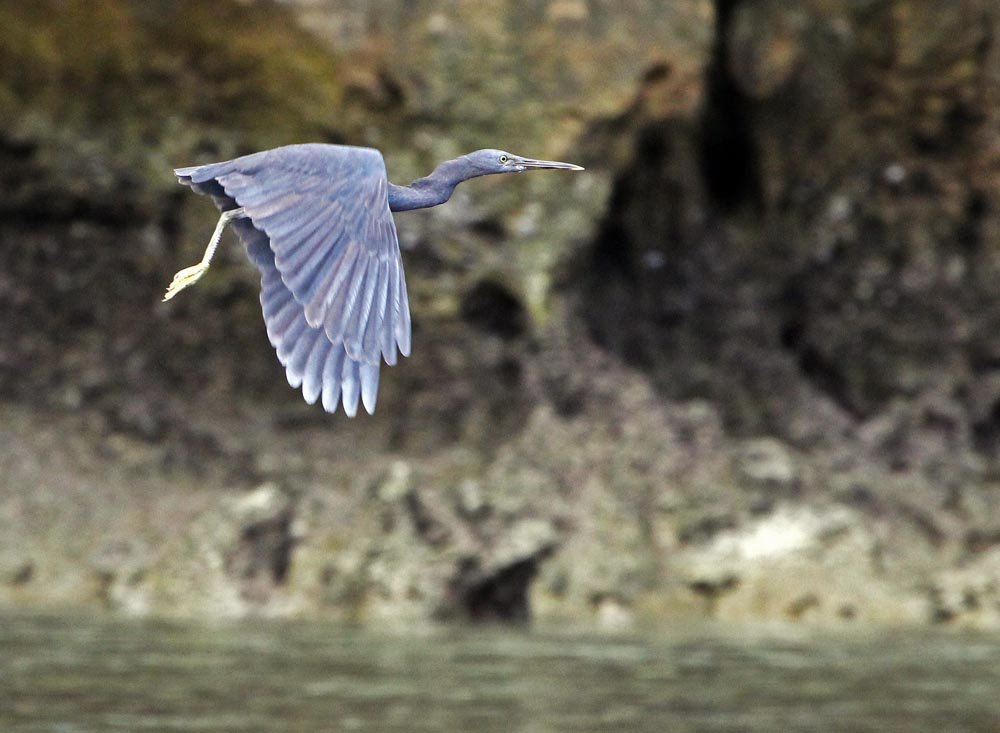 Eastern Reef Egret, in flight, (Misool, Indonesia)
Eastern Reef Egret, in flight, (Misool, Indonesia)Places to see the Indo-Pacific tropical seashore
In the north east of Australia is the muddy but birdy Cairns esplanade. The east coast of Queensland is of course dominated by the Great barrier Reef and includes Lizard Island, and Michaelmas Cay. On the north west coast of Australia is Broome, and the Lacepede Islands. and there are birds breeding on the islands of Ashmore Reef.
Across the Coral Sea is the Solomon Islands with the Arnavon (Arnarvon) Islands. New Guinea includes the remote Alim Island.
North of Australia is Indonesia, with explosive Krakatoa. More remote are the tropical Pacific islands. The Cook Islands include the stunning Aitutaki Atoll. North into the Micronesian islands is Palau. Out in the very remote eastern Pacific are the Pitcairn Islands.
On the other side of the Indian Ocean, off the coast of Africa, are the Seychelles. Included in this island group is Farquhar Atoll.
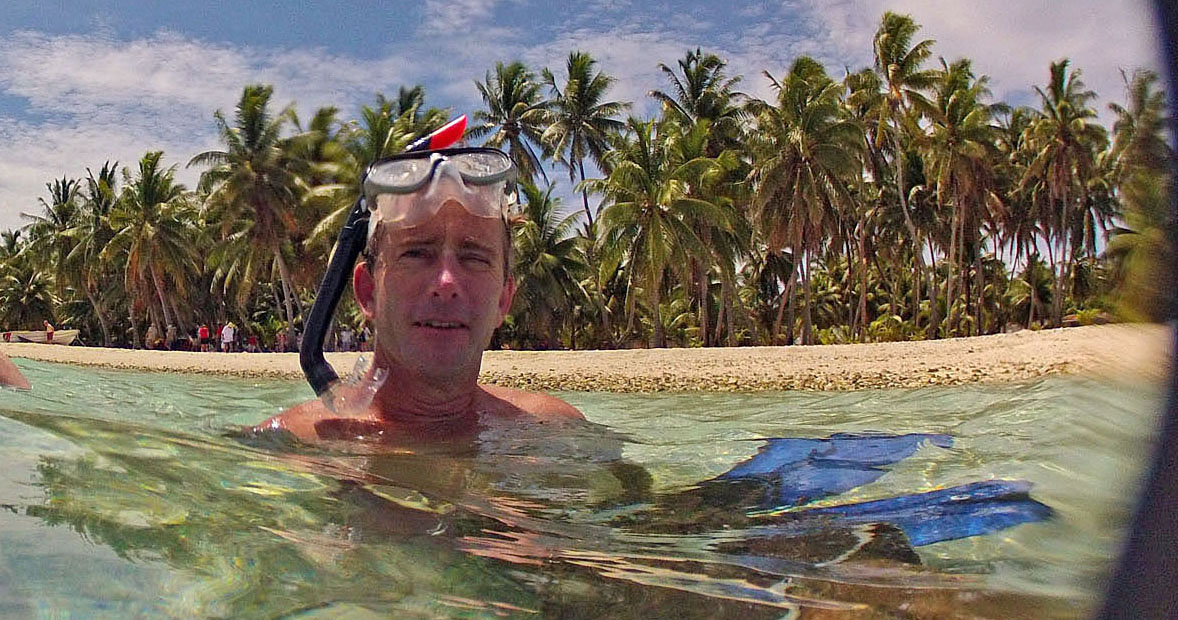 The author Damon Ramsey, taken in Cook Islands 2013! (photo by Jamie Watts)
The author Damon Ramsey, taken in Cook Islands 2013! (photo by Jamie Watts)